Barcelona is renowned for its stunning architecture and sun-kissed beaches, and its rich cultural tapestry comes alive during the Festa Major de Gràcia or Gracia Festival. Held every August in the charming Gracia neighbourhood, this week-long celebration transforms the area into a kaleidoscope of colours, sounds, and activities. Before planning the trip, I hadn’t even heard of this festival, but after partaking in it, I can say it was one of the best experiences and the most interesting festivals I’ve ever attended anywhere in the world!
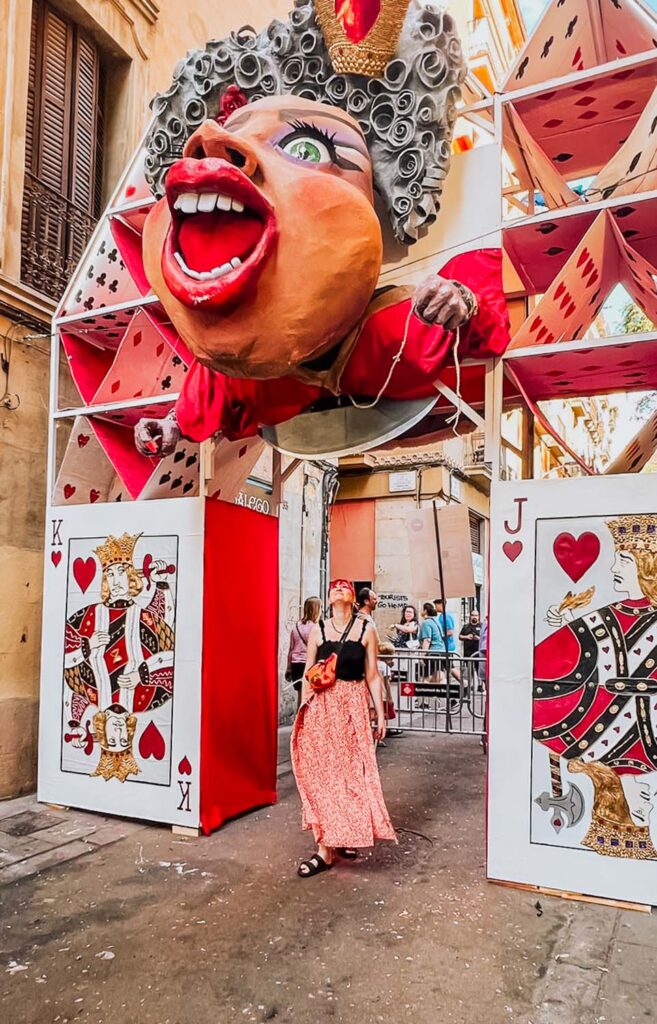
I was lucky enough to return to Gracia in 2023 to stay for the entire length of the festival and take part in a multitude of activities throughout the festival, enabling me to share with you all the incredible aspects of this incredible Spanish festival.
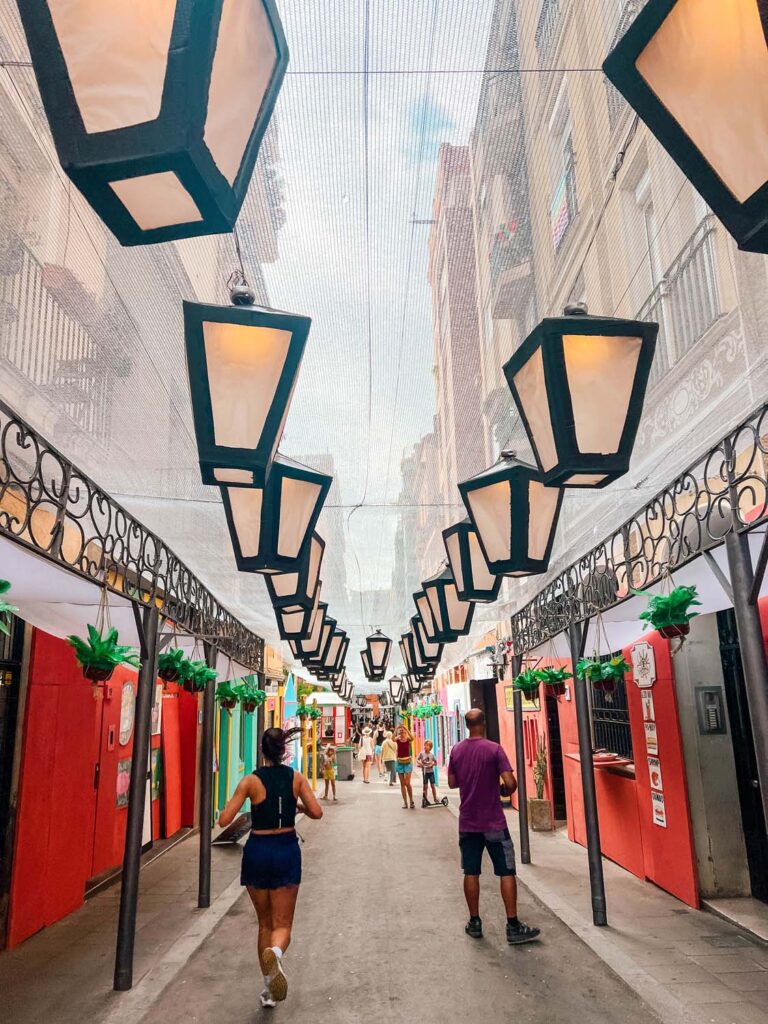
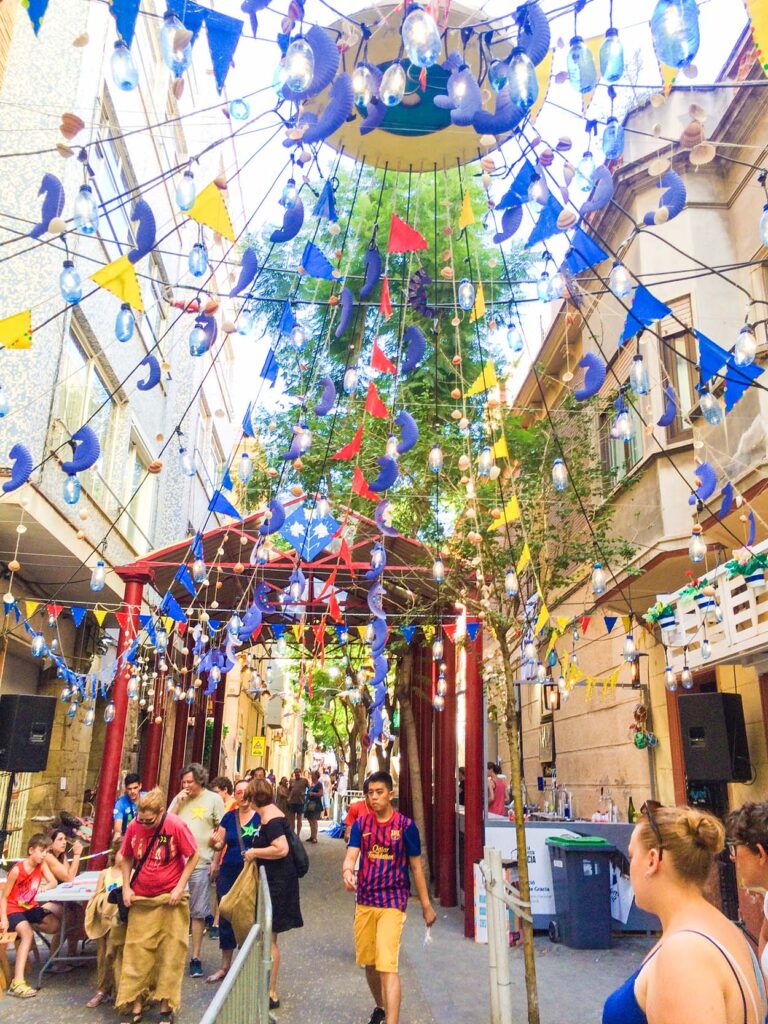
About the Festival
The Gracia Festival, or Festa Major de Gracia, is an annual event that dates back to the 19th century. It’s a time when the community comes together to decorate their streets in the most imaginative ways possible. Each street in Gracia competes for the title of the best-decorated street, and the results are nothing short of spectacular. Themes range from whimsical fairy tales to intricate historical recreations and movies, all crafted with incredible attention to detail.
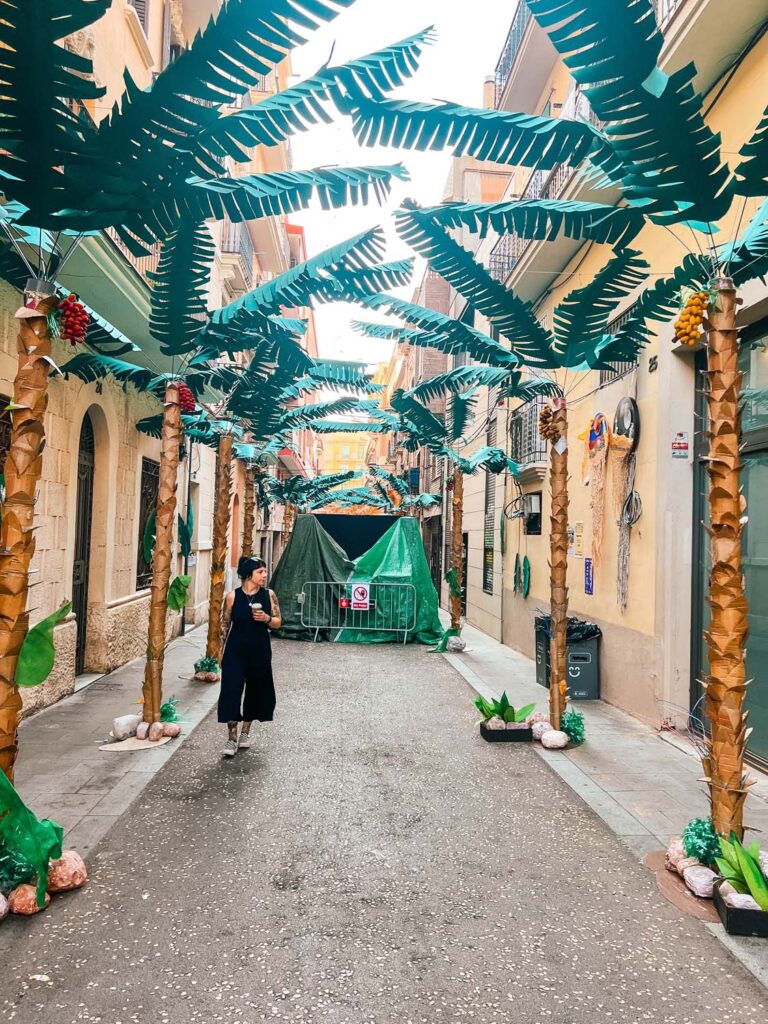
The Festival also emphasizes sustainability and environmental awareness. Recently, a concerted effort has been made to use recycled materials for decorations and promote eco-friendly practices among participants and visitors.
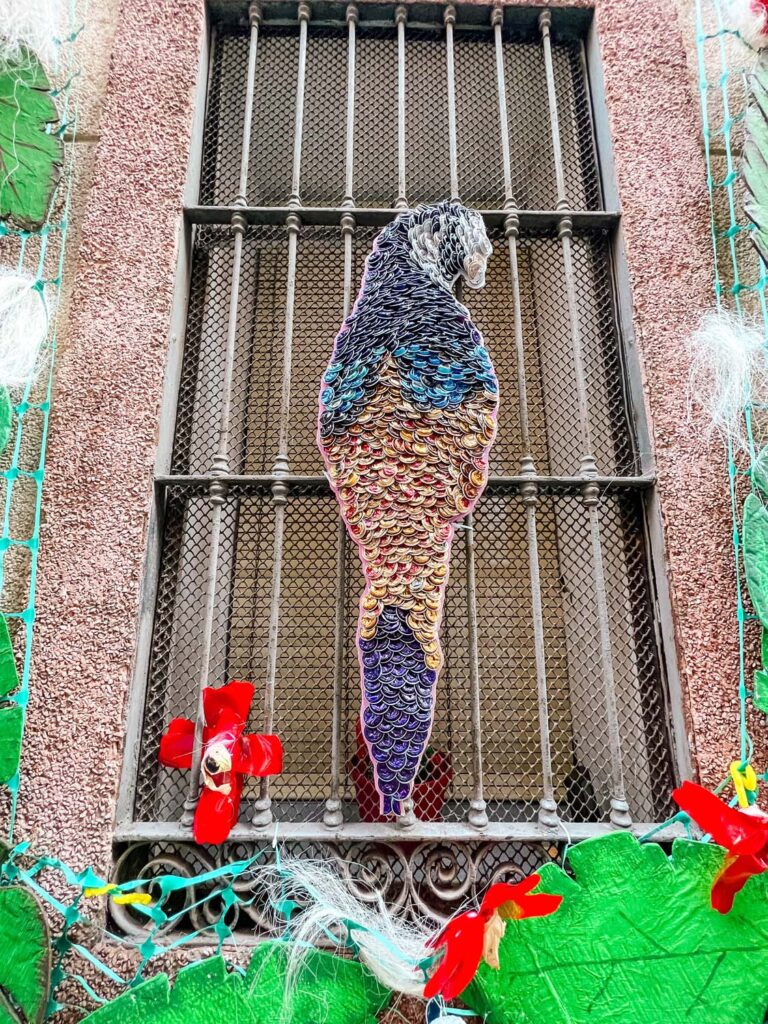
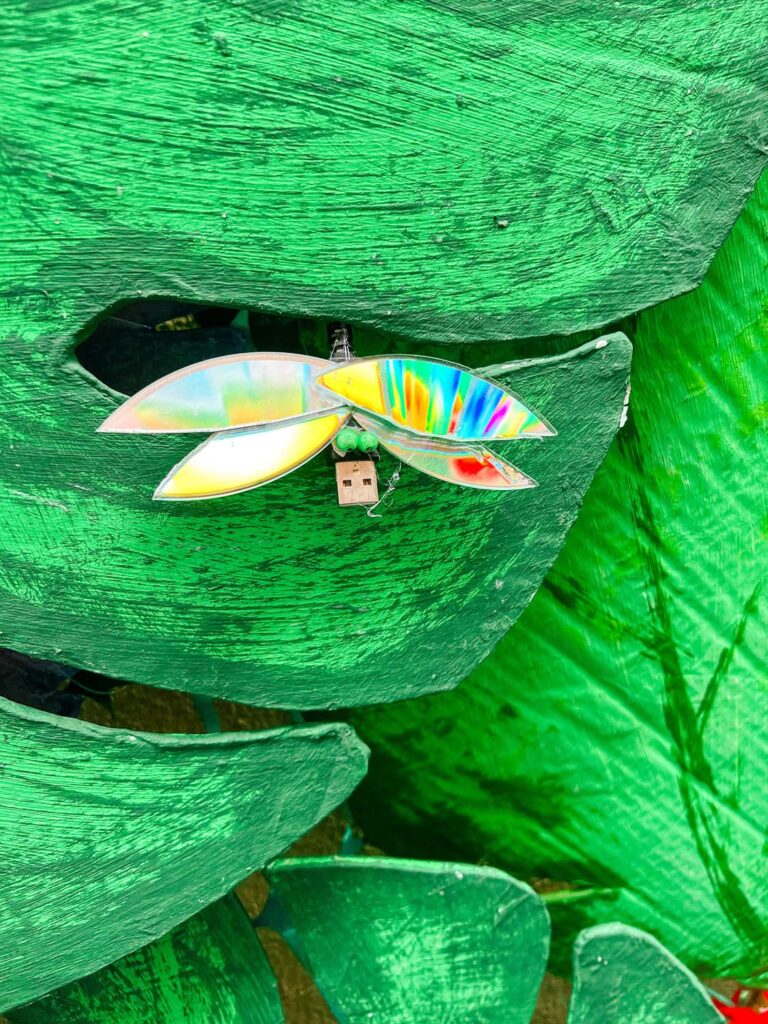
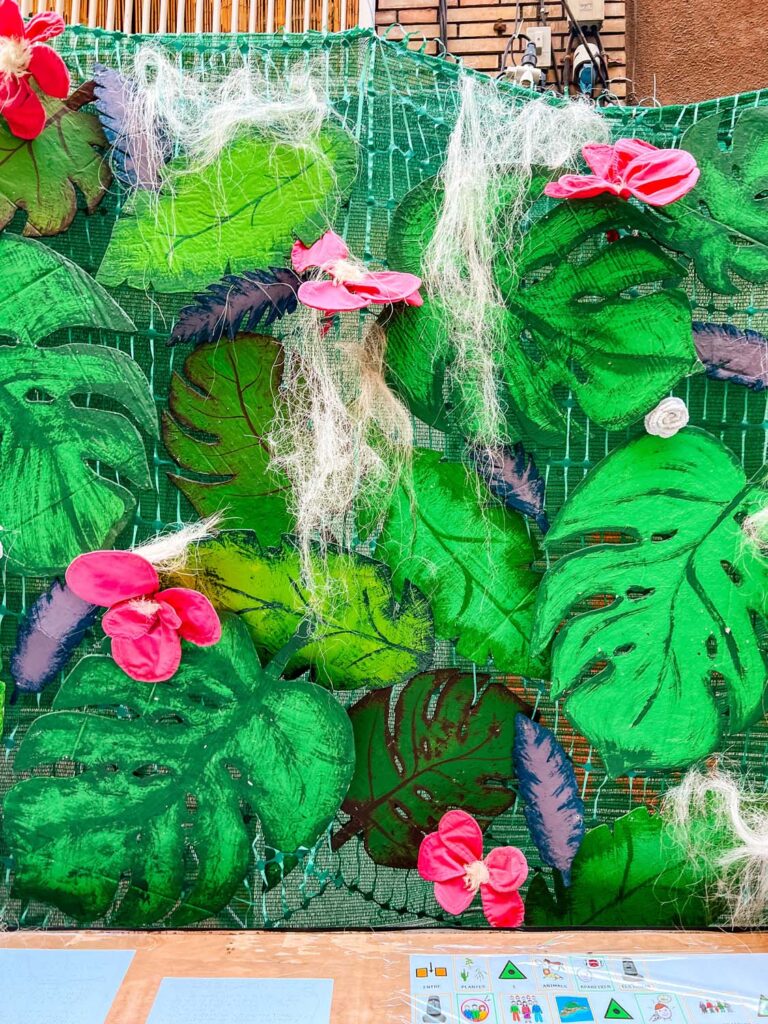
Residents themselves organize the creation and installation of the decorations and, throughout the entire year, hold events to bring together the community to raise money and take part in creating these fantastical street installations. The festival is also packed with activities and events for all the family, so there is always something to do throughout the week-long festival.
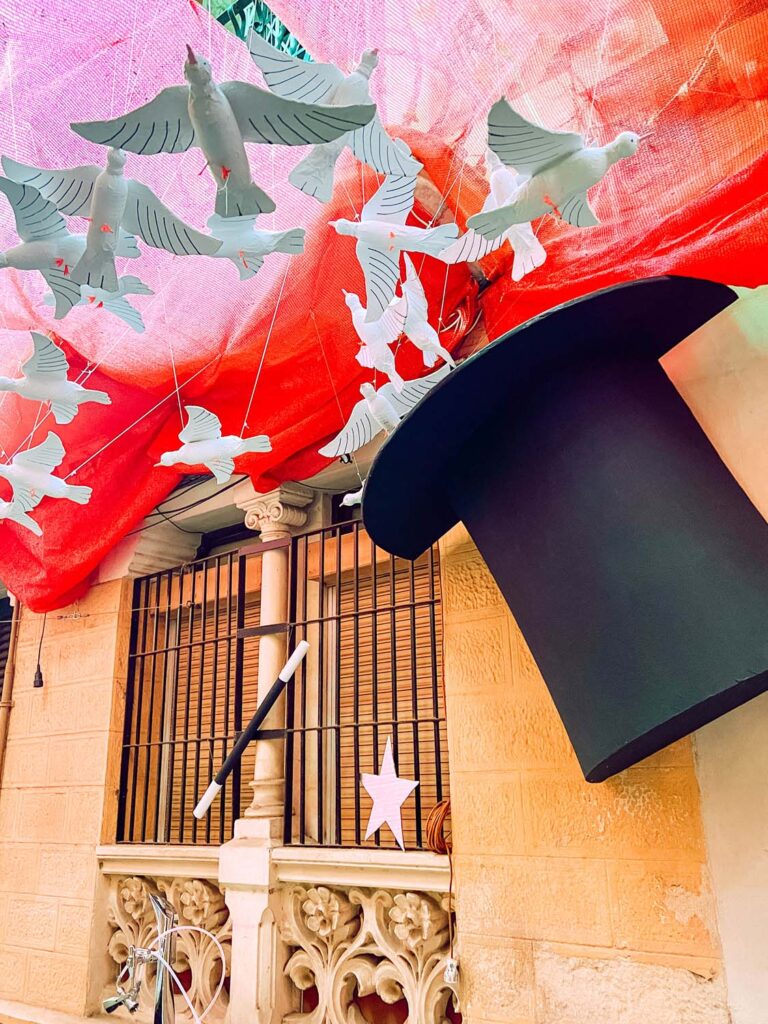
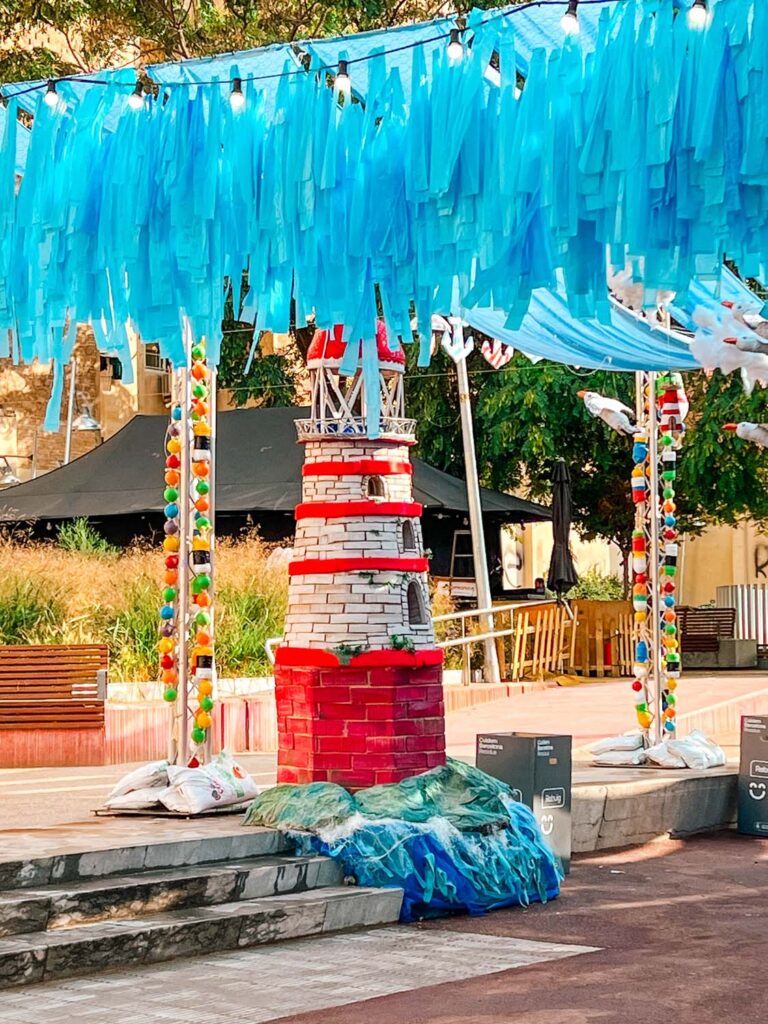
As you explore Gracia, you’ll find yourself mesmerized by the creativity and effort that goes into each street’s decorations. One street might transport you to an underwater world, complete with paper-mâché sea creatures and shimmering blue lights. Another might recreate a medieval castle, with towering cardboard turrets and knights in shining armor. The ingenuity and craftsmanship on display are truly awe-inspiring.

About the Gràcia Neighbourhood
The Gracia neighbourhood, known for its bohemian charm and vibrant cultural scene, is one of Barcelona‘s most beloved districts. Its origins date back to the early 17th century, when it was established as a small rural village outside the walls of Barcelona. Initially, it was known as “Villa de Gracia,” a name derived from the Nuestra Señora de Gracia Convent, around which the village grew.
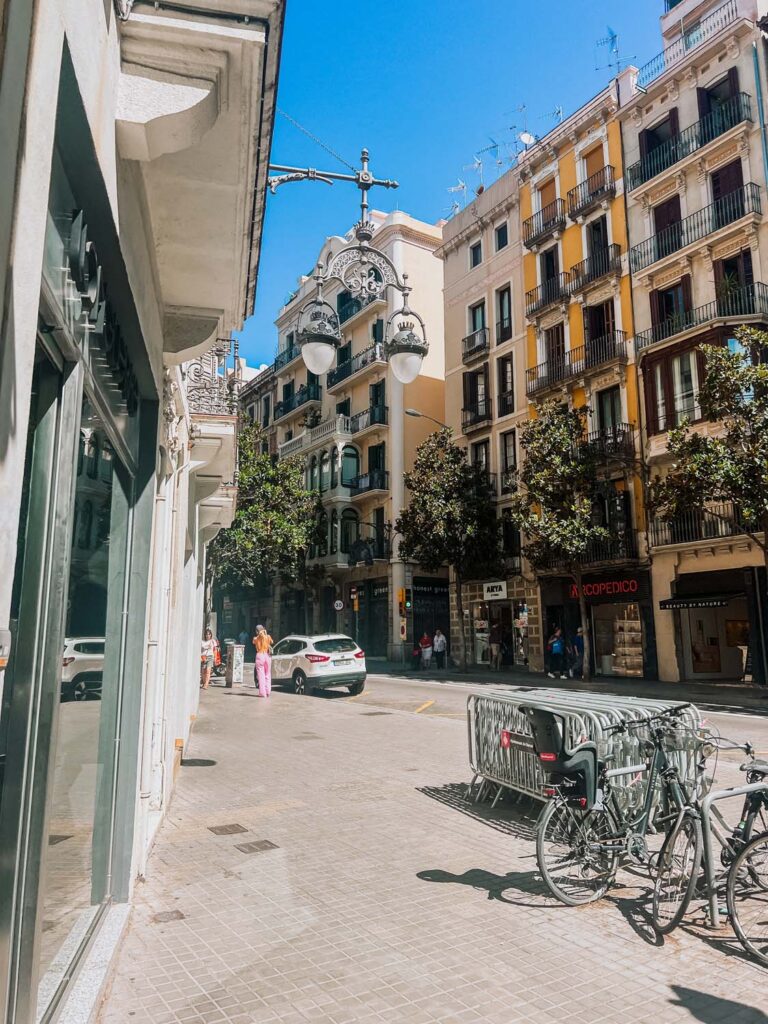
Throughout the 19th century, Gracia underwent significant transformations. As Barcelona expanded, the once-separate village began to attract artisans, workers, and intellectuals seeking a quieter, more affordable alternative to the crowded city center. Despite Gracia’s eventual incorporation into the greater city of Barcelona, Gracia retained its distinct character, with narrow streets, small squares, and a strong sense of local identity, including the iconic Gracia Festival.
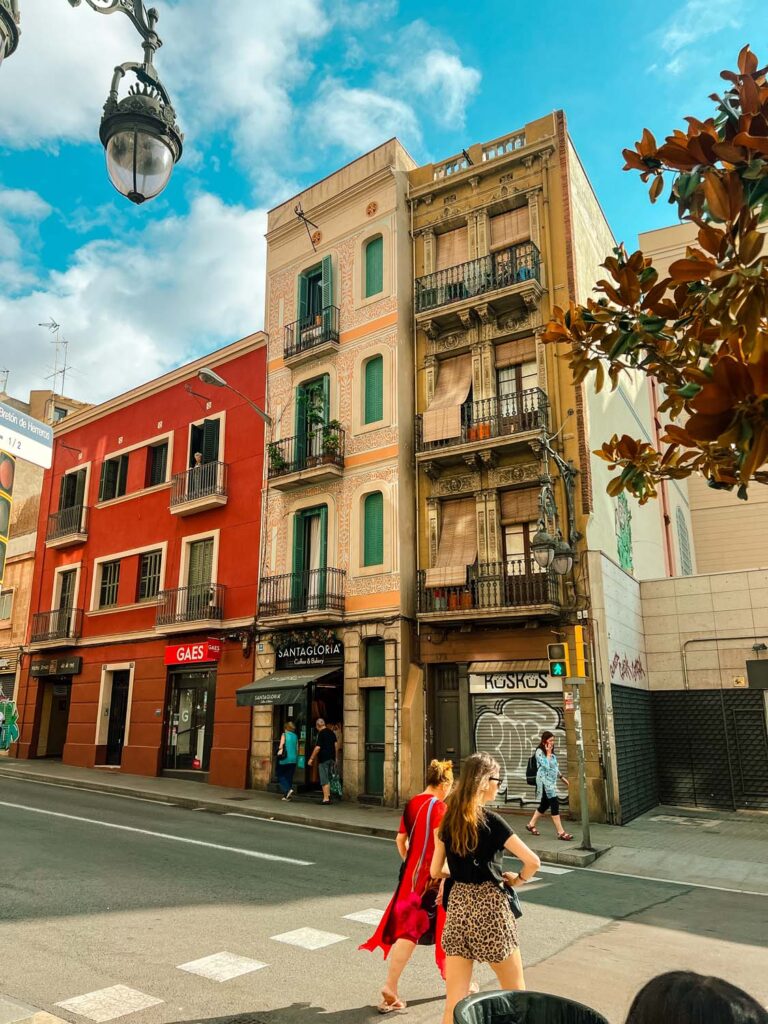
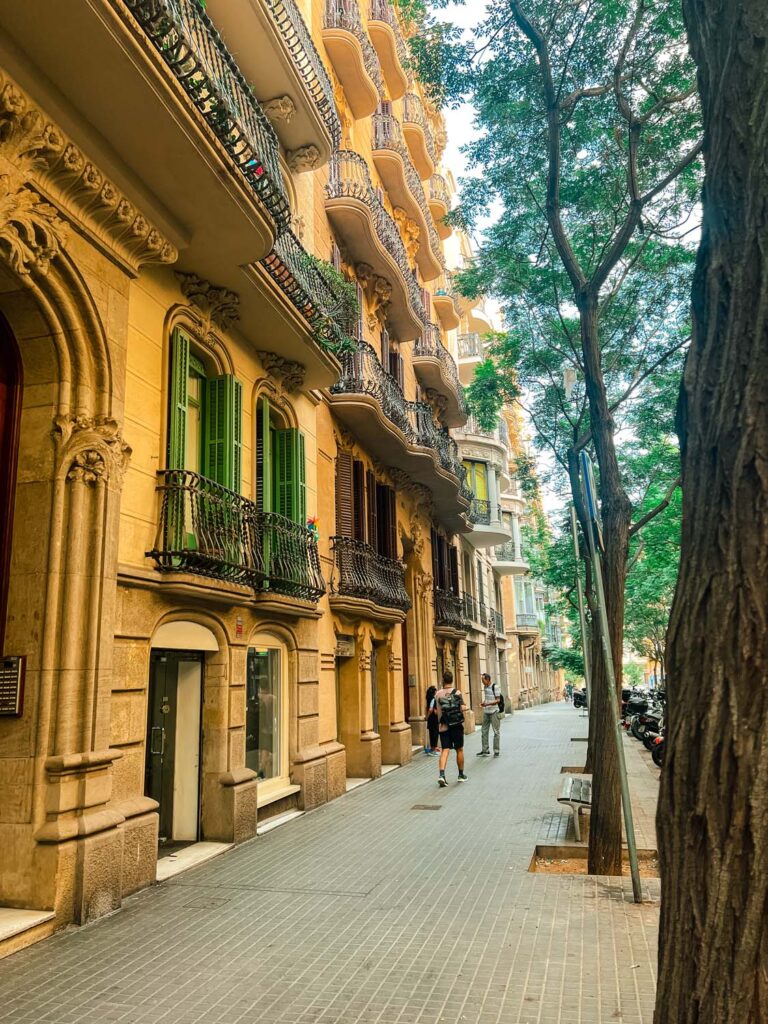
History of the Festival
Held annually in the Gracia neighbourhood, this vibrant festival has a rich history that reflects the community’s creative spirit and deep-rooted traditions. The origins of the Gracia Festival can be traced back to the early 19th century. The festival began as a local celebration honouring the Assumption of Mary, the patron saint of the Gracia neighbourhood. This religious event, held on August 15th, gradually became a broader community celebration as the neighbourhood grew and diversified.
The festival was marked by processions, religious ceremonies, and communal feasts. However, what set the Gracia Festival apart from other local celebrations was the unique tradition of street decoration. Residents began to adorn their streets with handmade decorations, transforming the neighbourhood into a stunning open-air exhibition of creativity and craftsmanship. This period also saw the establishment of neighbourhood associations, or “commissions de festes,” which played a crucial role in organizing the festival. These associations were responsible for planning events, coordinating street decorations, and fostering a sense of community spirit. The friendly competition between different streets to create the most impressive decorations became a hallmark of the festival.
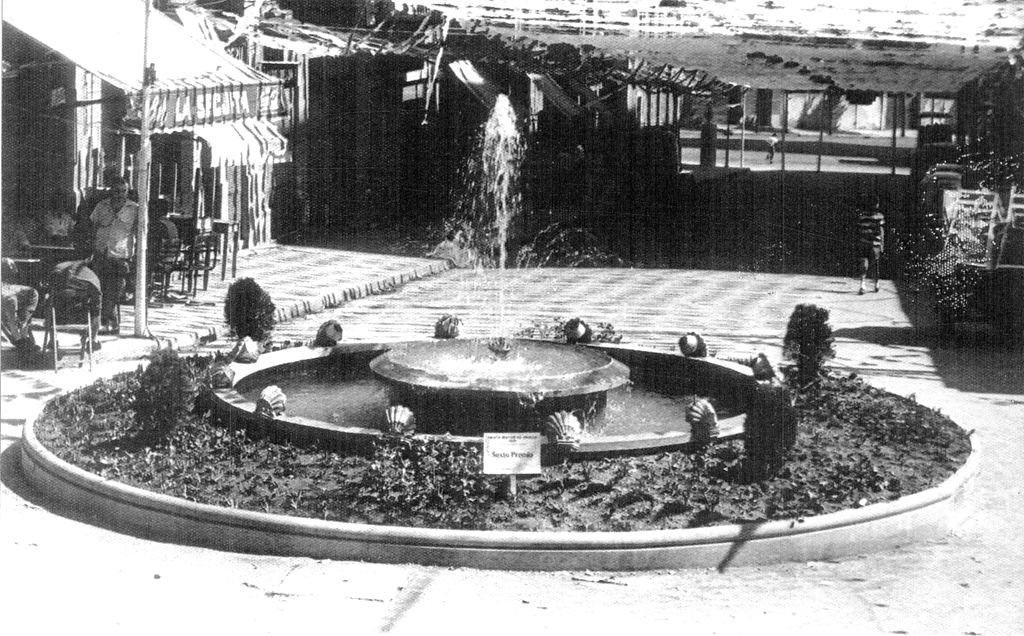
Civil War and Modern Resurgence
During the Spanish Civil War and the subsequent Franco dictatorship, the Gracia Festival faced significant challenges. Political repression suppressed the festival, and many traditional activities were curtailed. However, the community’s resilient spirit ensured that the festival endured, even in a more subdued form. With the return of democracy in the late 1970s, the Gracia Festival experienced a renaissance. The restoration of civil liberties allowed for a resurgence of cultural and artistic expression. The festival once again became a vibrant celebration of community and creativity, attracting participants and visitors from across Barcelona and beyond.
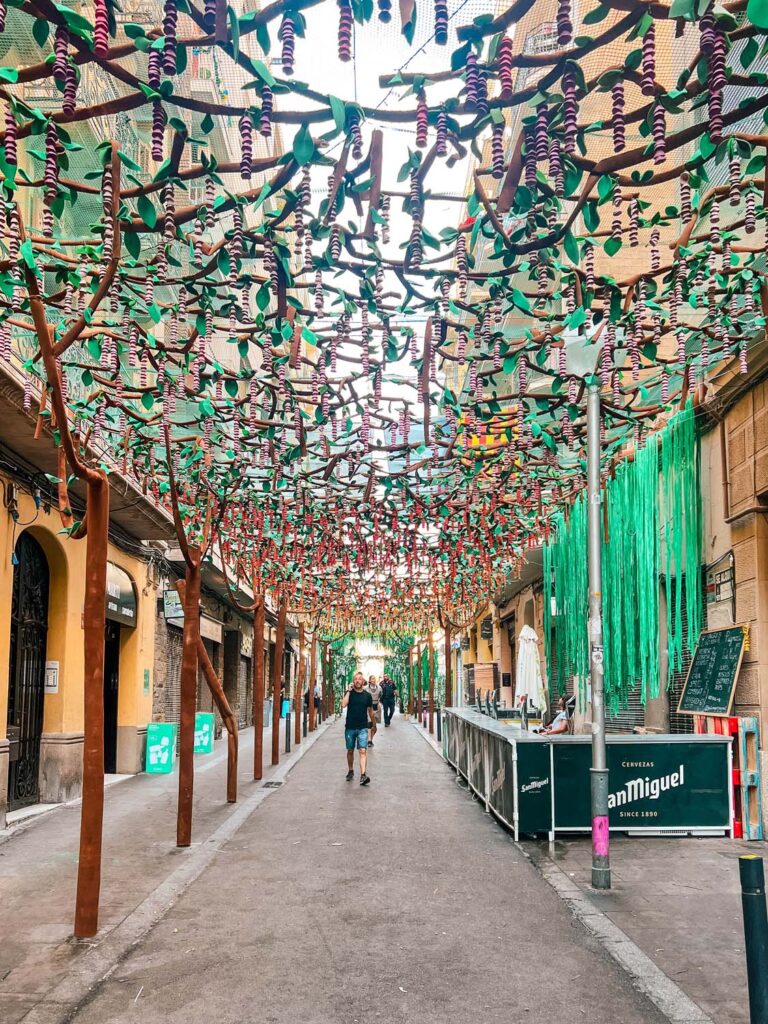
When Does the Festival Take Place?
The Festa Major de Gracia always takes place in August. The official dates for 2024 are August 15th 15th to August 21stst. The best place to find the most updated information on the Festa Major de Gracia is through their website or their social media accounts.
How to Get There
The Gràcia festival takes place across the entire barrio (Catalan word for neighbourhood), but the best place to start is in one of the large squares, where you can pick up your copy of the festival guide. Even though these guides are in Catalan only, I find the map easy to follow even for non-Catalan speakers.
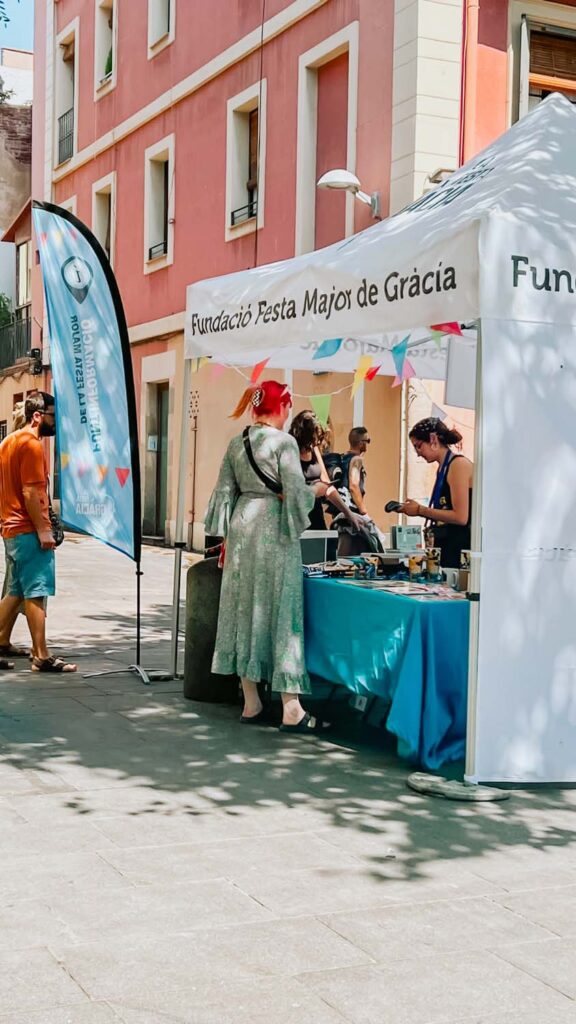

To make your way to the Festa Major de Gracia, hop on the metro and get off at Fontana station on the Green Line, L3. This metro stop will land you right at the heart of Gràcia. Do not try to drive the car anywhere near the festival. So many streets are completely closed to traffic, even for the locals, as this is where they set up for the festival installations, and many other streets are closed for visitors and pedestrians.

Do You Need Tickets?
The Festa Major de Gracia is completely FREE! There is no need to purchase tickets in advance or at the festival. The program guide will cost you just one euro\, and while you can also use the app for free, the money for your program is also a donation to the festival organizers, so I’d recommend picking one up! In addition, they often have some festival merchandise such as drink cups and t-shirts for sale, which are another great way to give back to the festival organizers.
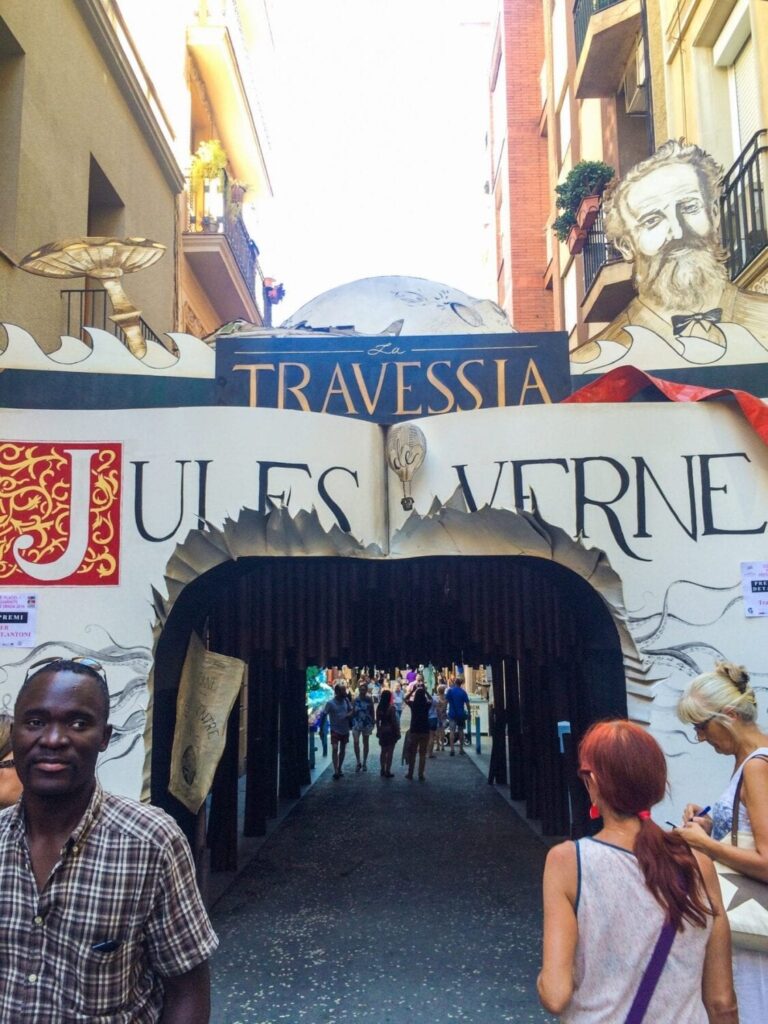
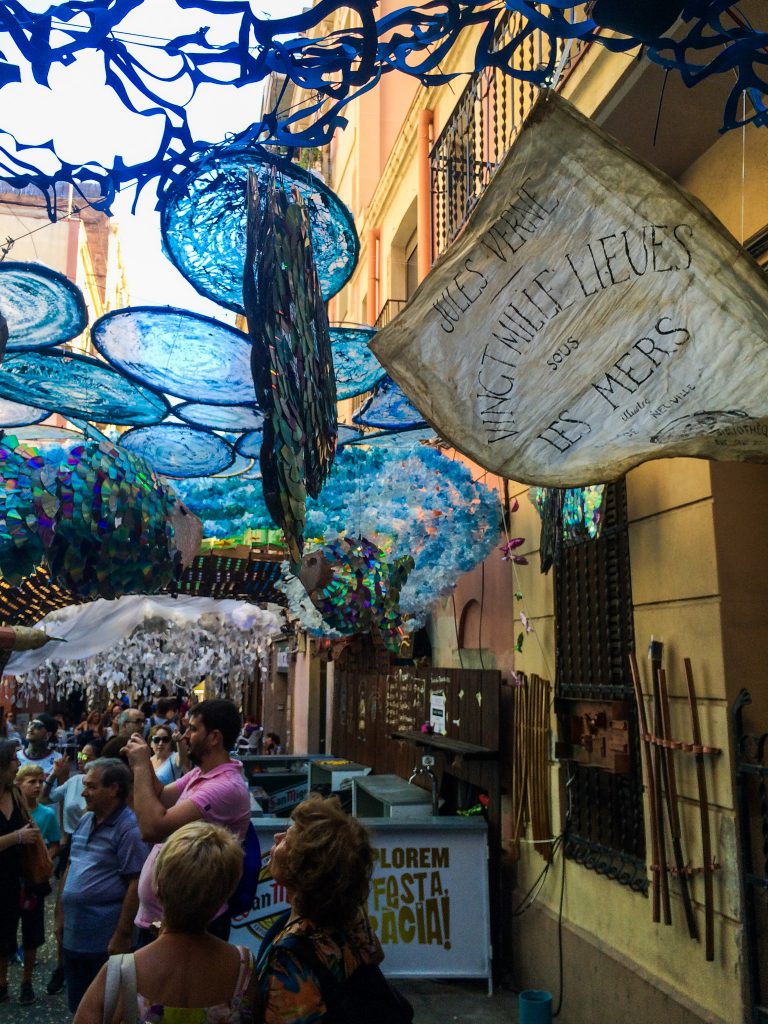
Where to Explore?
When you arrive in Gràcia, seek out a festival information station in Fontana Square, where you can grab a map of the street to visit. If you prefer, you can also download a handy-dandy app that will tell you what you’ll find around the various streets and how to get there. Although every street is worth seeing, the most famous streets that have won the “best street award” year after year are the Carrer de Joan Blanques and Carrer de Verdi. There are over 20 streets and squares around Gràcia that participate in the festival, and since Gracia is such a small neighbourhood, you can easily just wander and explore, and you’ll easily come across dozens of multicoloured streets that transport you around the world in one place!
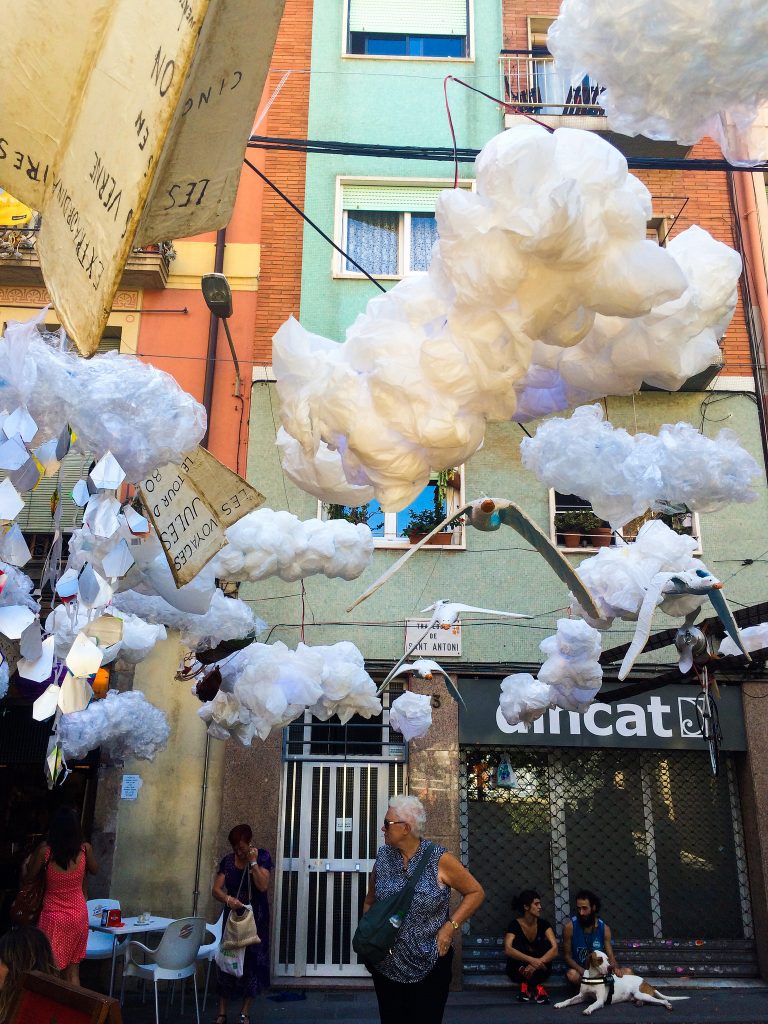
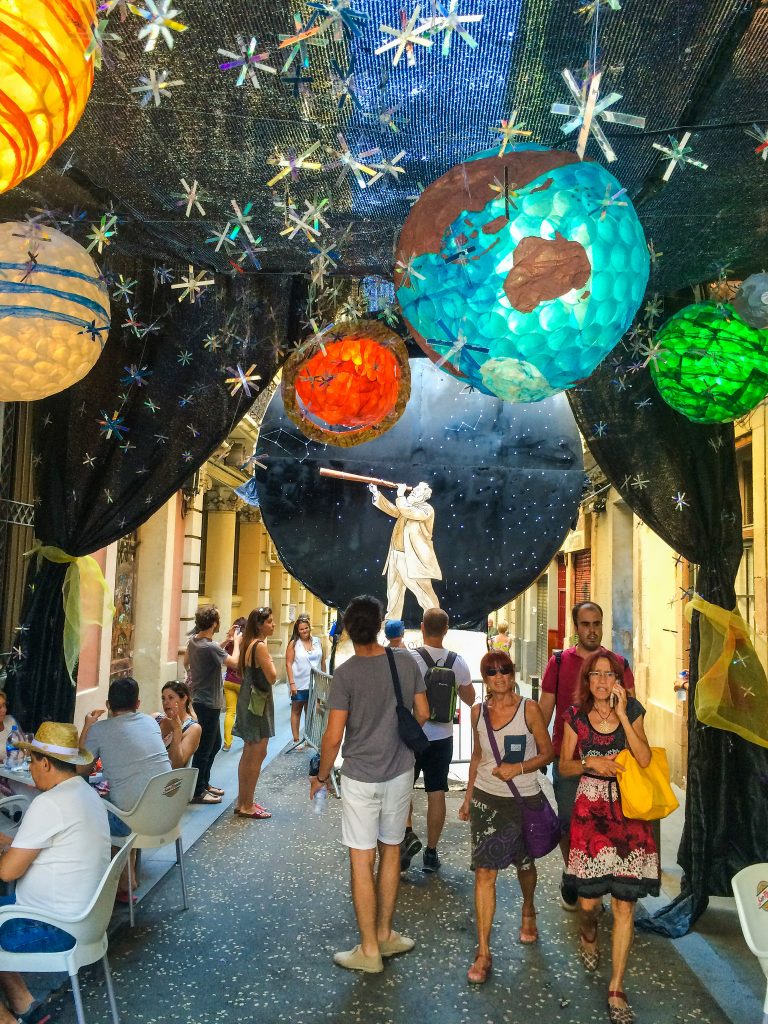
How to Respect the Community & Be a Good Visitor
As a visitor to the Gracia Festival or Festa Major de Gracia, respecting the local community and their cherished traditions is essential. Barcelona has seen an influx of tourism in recent years. While the city welcomes visitors, there’s a growing sentiment among locals to preserve the character and tranquillity of their neighbourhoods.
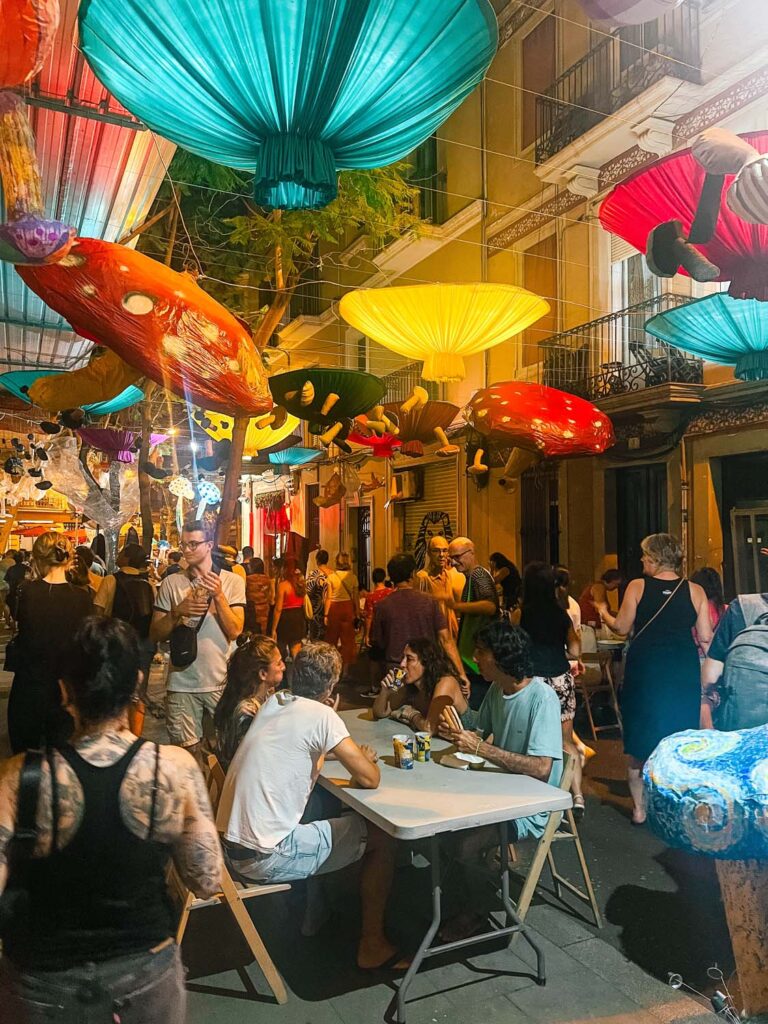
To show respect, always dispose of litter properly and avoid excessive noise, especially late at night, even if you see others doing the opposite. Remember, you are a guest and should feel honoured to be welcomed into this space.
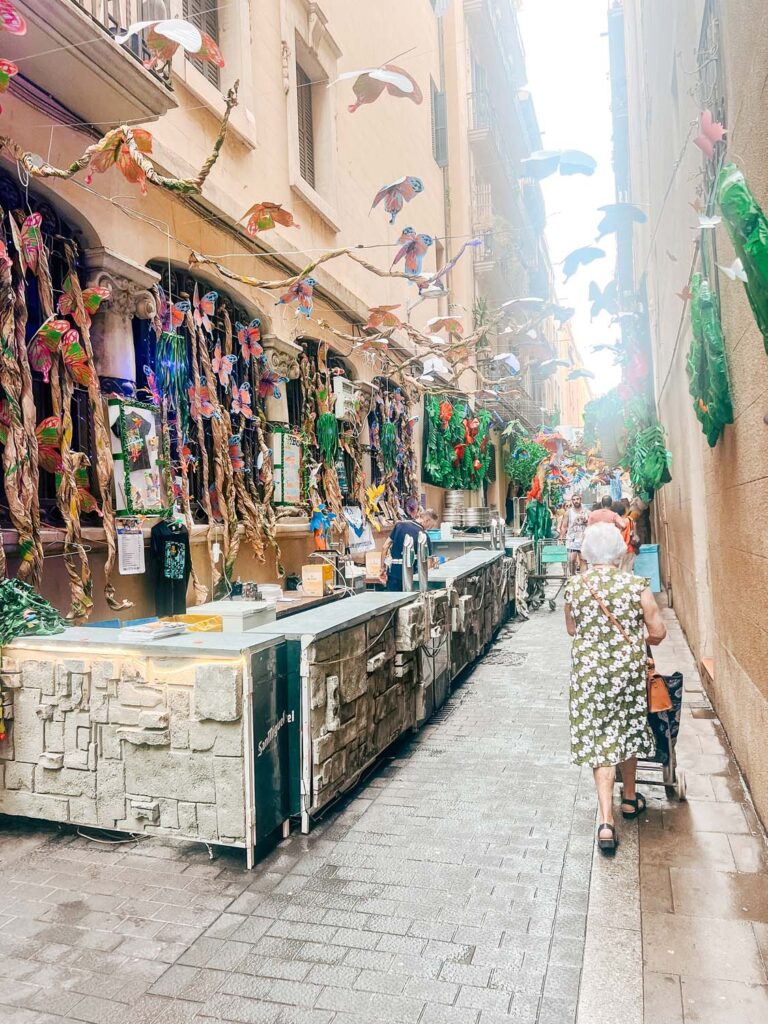
Engage with the festival in a way that honours the efforts of the residents who have painstakingly prepared their streets—admire the decorations without damaging them and follow any guidelines set by the organizers. But the most important thing to remember is to help support local businesses by purchasing food, drinks, and souvenirs from neighbourhood vendors, contributing positively to the local economy.
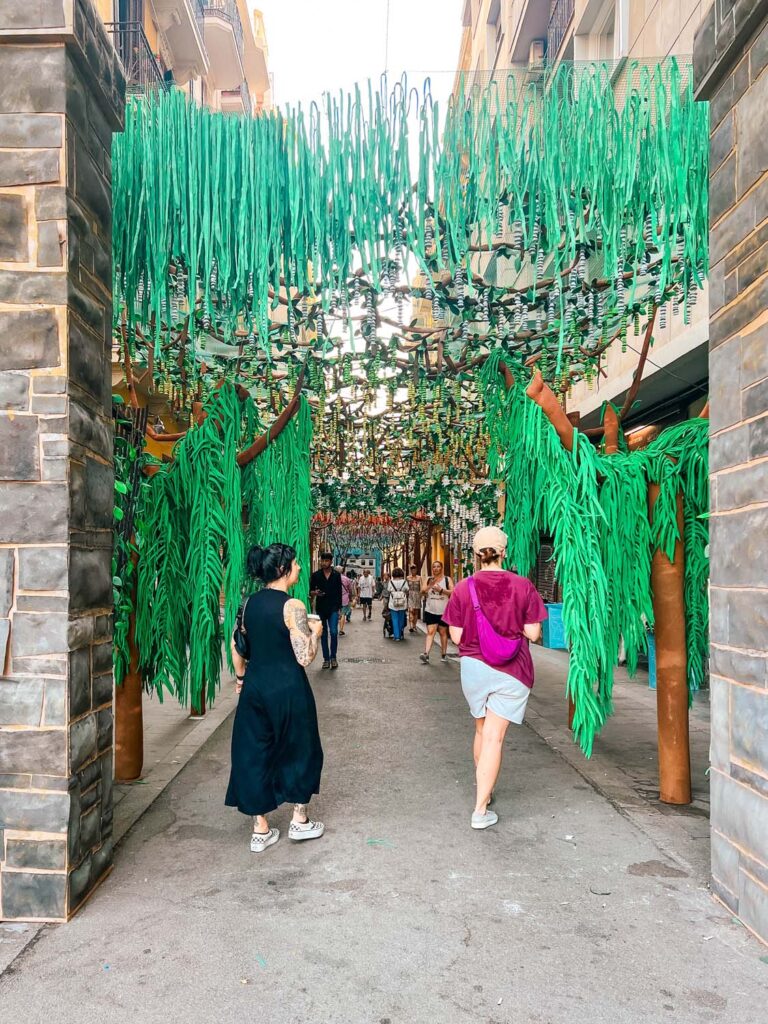
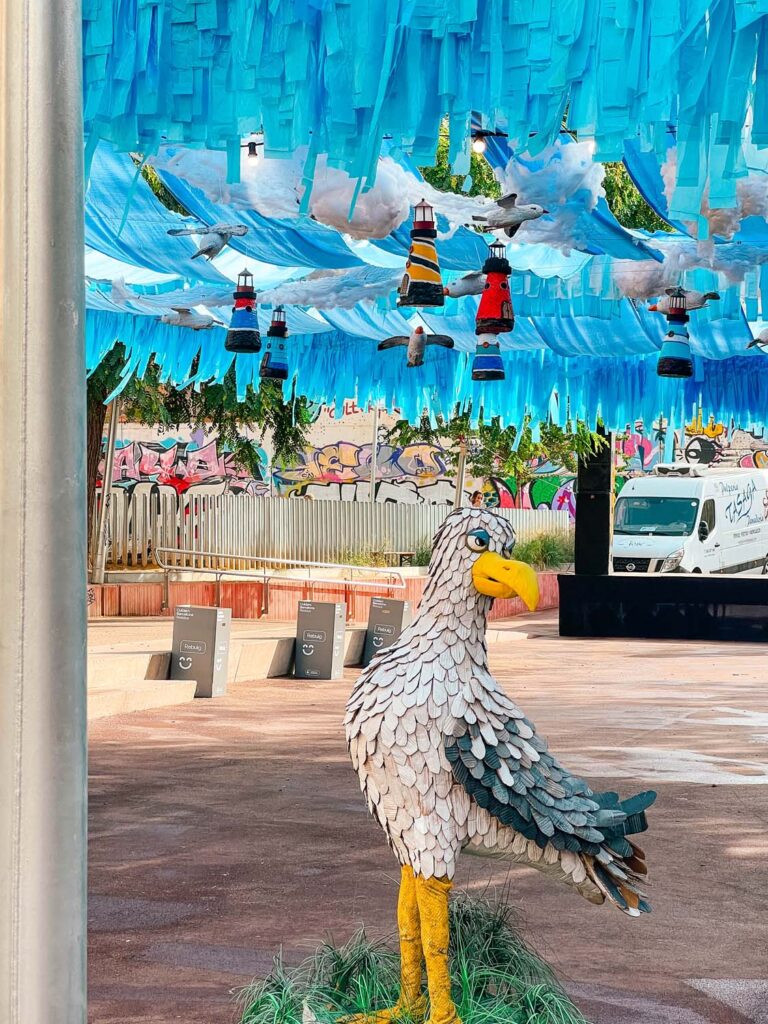
Events at the Gracia Festival
While the primary draw to the Festival is to explore the brightly coloured street decorations, the Festival’s program has expanded to include various activities, such as concerts, theatrical performances, and sporting events.
The Grand Opening
The Festival starts with a grand parade that winds through the neighbourhood’s narrow streets. Giant puppets, dancers, and musicians lead the procession, creating a festive atmosphere that immediately draws you in. People wear enormous papier-mache heads called ‘capgrossos’ and dance throughout the streets. People walk on stilts, and musicians entertain the crowds throughout the day. It feels like a giant circus pouring through the city’s narrow streets.
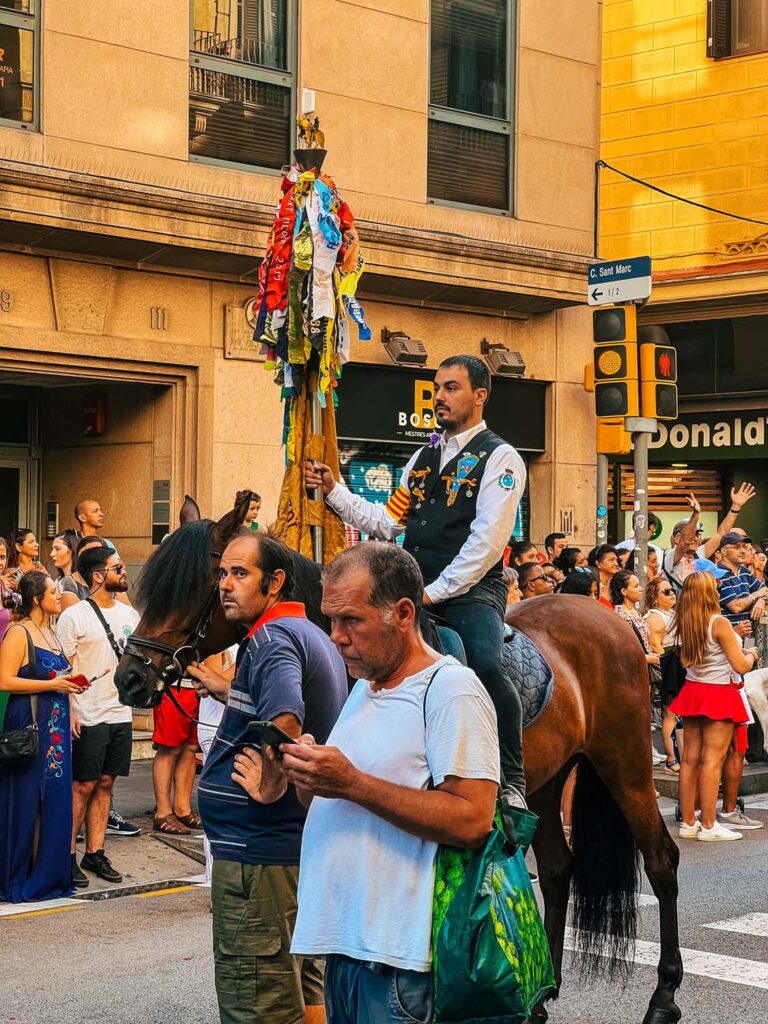
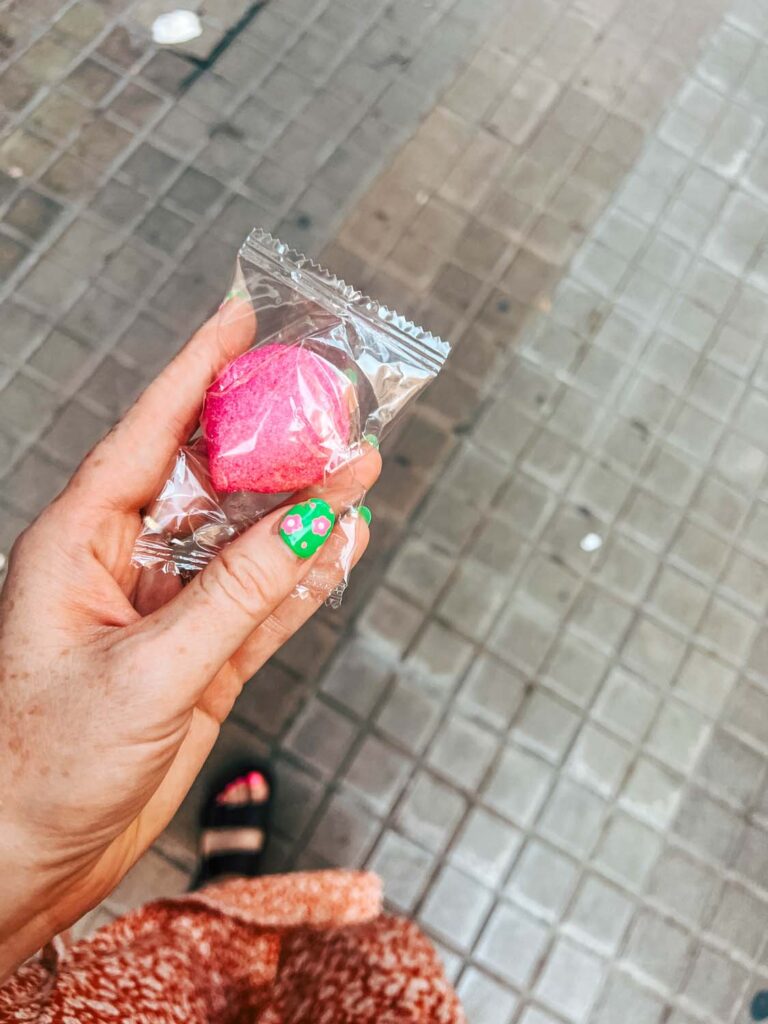
Castellers, the human towers of Gràcia
The Gràcia festival features one of the most traditional Catalan events, Castells. The tradition of building human towers, known as “castells,” is one of Catalonia’s most unique and awe-inspiring cultural practices. Castellers, the skilled participants of this art form, gather in Gracia’s town squares to construct a human tower by stacking layers of people, one on top of another, in a precise and coordinated manner. The formation begins with the “pinya,” and subsequent layers, or “tronc,” are built by progressively smaller and lighter castellers. Each layer stands on the shoulders of the layer below, carefully balancing and supporting one another. The higher levels require exceptional balance, strength, and trust among the castellers.
During one of the festival nights, they have an event called the Baixada del Pilar Caminat, where they not only build a tower made of humans but also move it between two plazas. It’s a nerve-bending feat of human aptitude and an entertaining performance to see live!
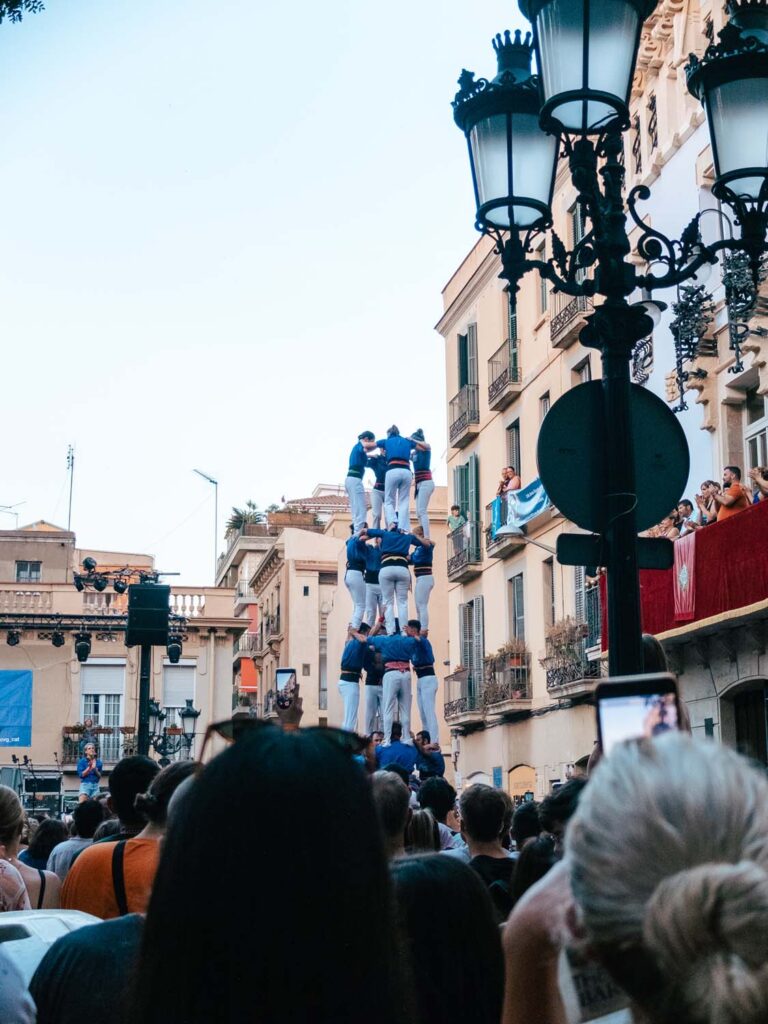
The Gràcia Correfoc or Firerun
The correfoc, or fire run, is a thrilling highlight of the festival and my personal favourite moment throughout the week. During the Correfoc, the streets of Gracia are plunged into a dramatic display of fire and pyrotechnics. Participants, known as “diables” (devils), dress in elaborate costumes and masks, carrying pitchforks and other devices that shoot sparks and fireworks. Often, these devils are little children, which might come as a surprise, but since this tradition is passed on through generations, kids must take part even from an early age.

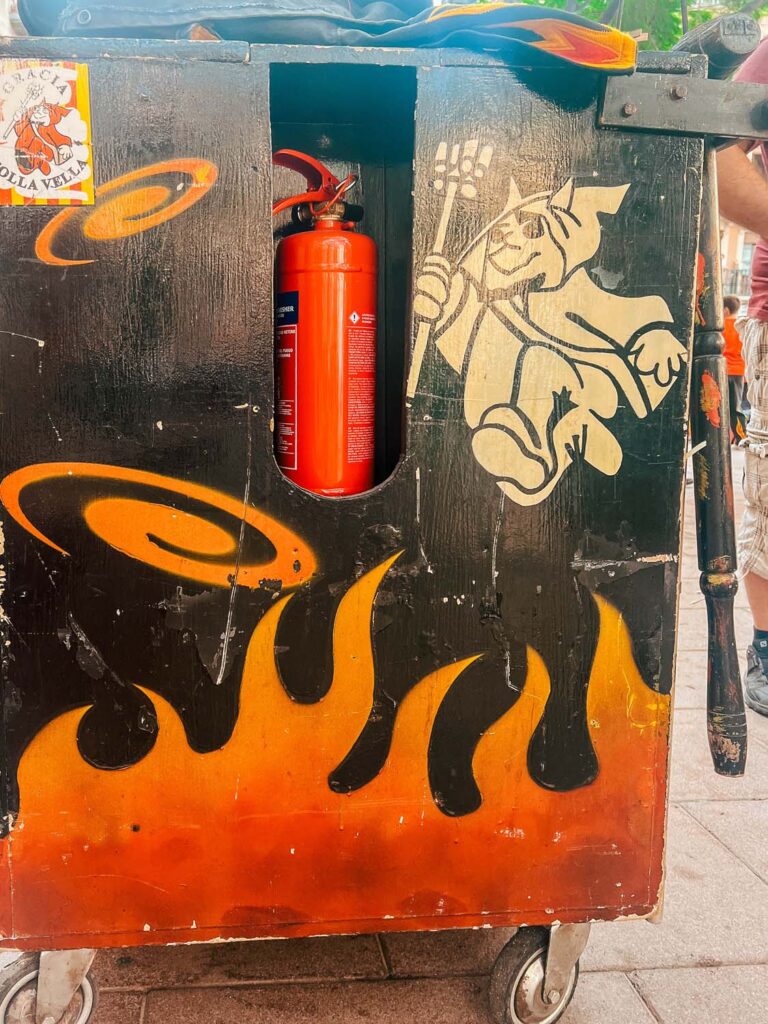
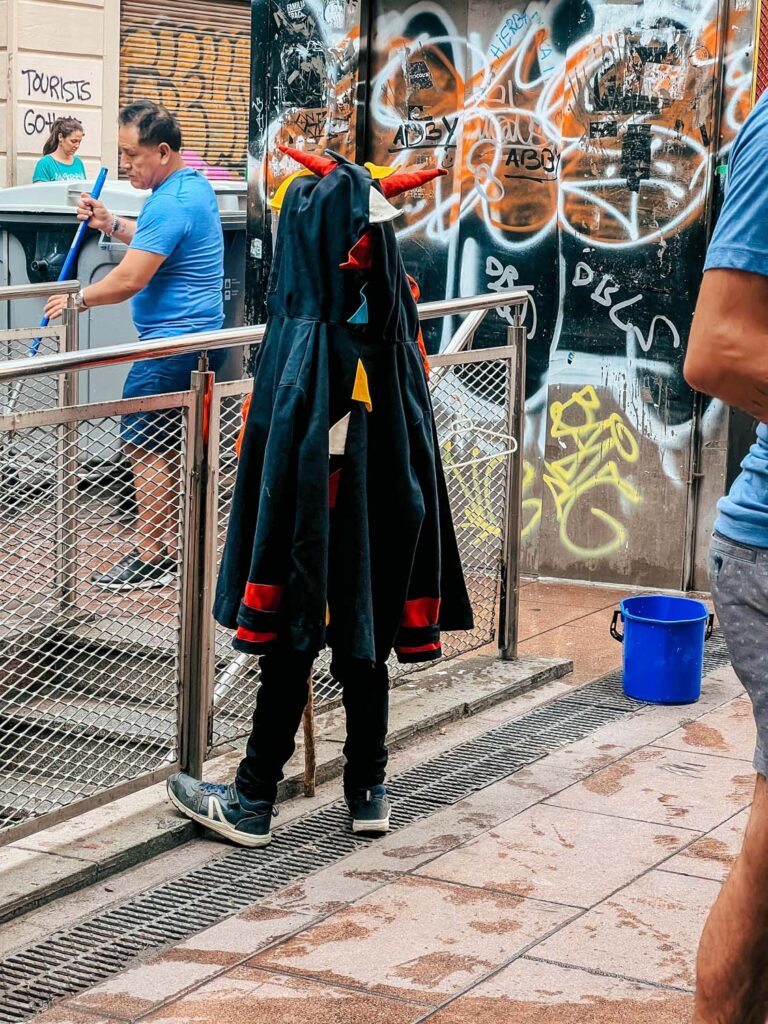
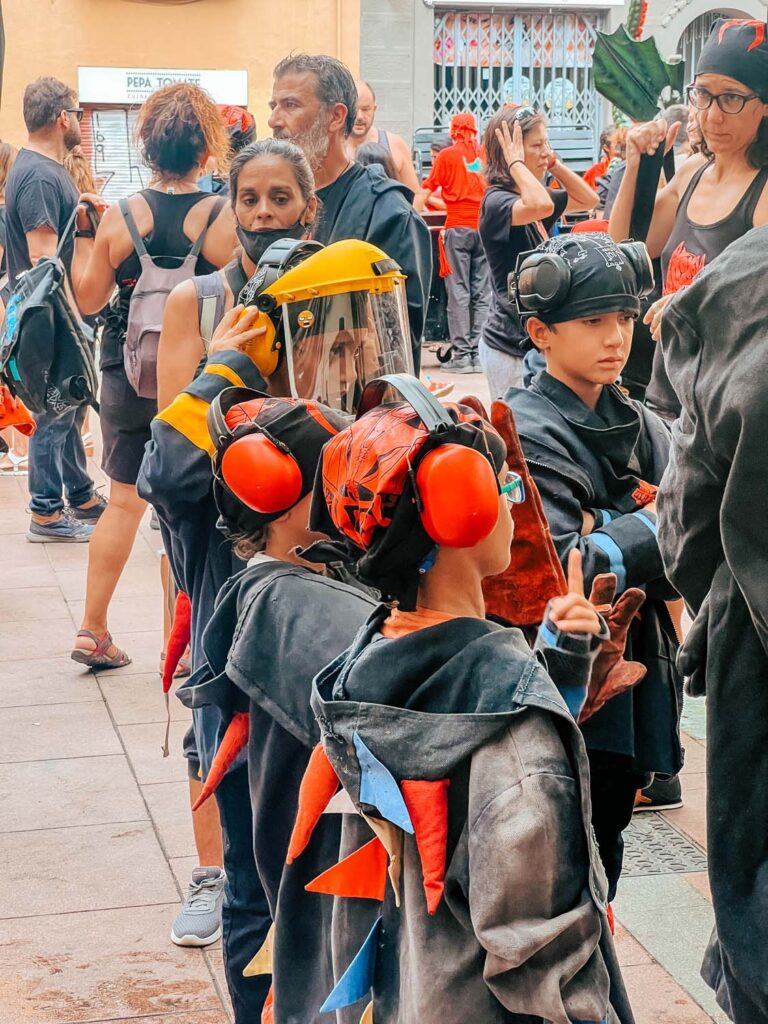
The event begins with the “tabalada,” a drumming performance that sets the pace and builds anticipation. As the drumming reaches a crescendo, the diables emerge, and the Correfoc begins. The drummers walk through the streets with the devils, creating the most rhythmic beats to match the bangs of the fireworks. It’s incredibly theatrical, unlike anything you’ll see elsewhere! The event starts very early in the morning, which is no doubt a shock to the locals who didn’t check the schedule, who will be rudely awoken at 9 am to the shrieks and bangs of the fireworks.
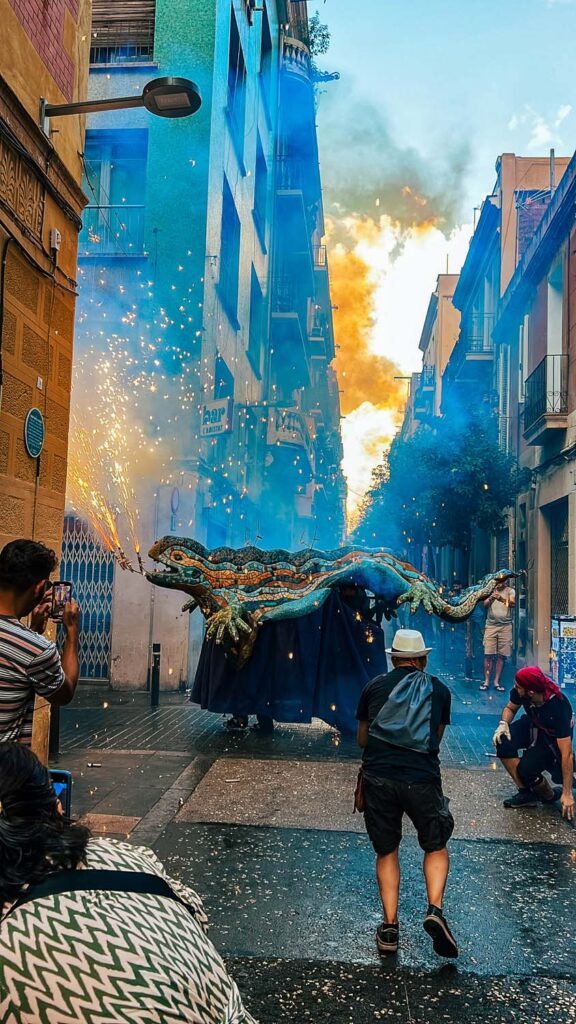
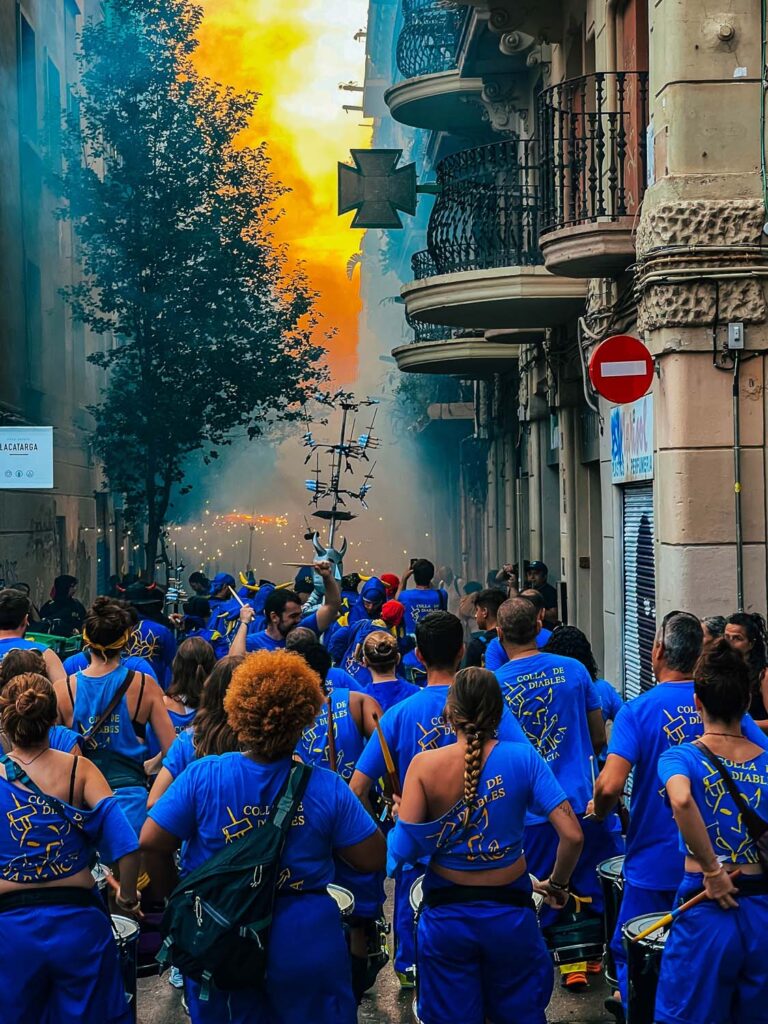
History of Correfoc
The origins of Correfoc can be traced back to medieval Catalonia. It evolved from the traditional “Ball de Diables” (Devil’s Dance), which depicted the eternal struggle between good and evil. Initially performed during religious and community celebrations, these performances involved characters representing devils, angels, and other mythological figures. Over time, the fire elements were incorporated, giving birth to the modern Correfoc. The Correfoc also serves as a symbolic representation of the triumph of light over darkness, good over evil.

Musical Stages and Performances
As the sun sets, the festival takes on a new dimension. Streets are illuminated with colourful lights, and the sounds of live music fill the air. Each night, different bands and performers take to the stage, offering diverse music, from traditional Catalan folk to contemporary rock. Dance floors spring up in every plaza, inviting you to join the revelry. The infectious rhythm of the “Sardana,” a traditional Catalan dance, is impossible to resist. We even found a stage that exclusively played death metal from 11 pm to 3 am!
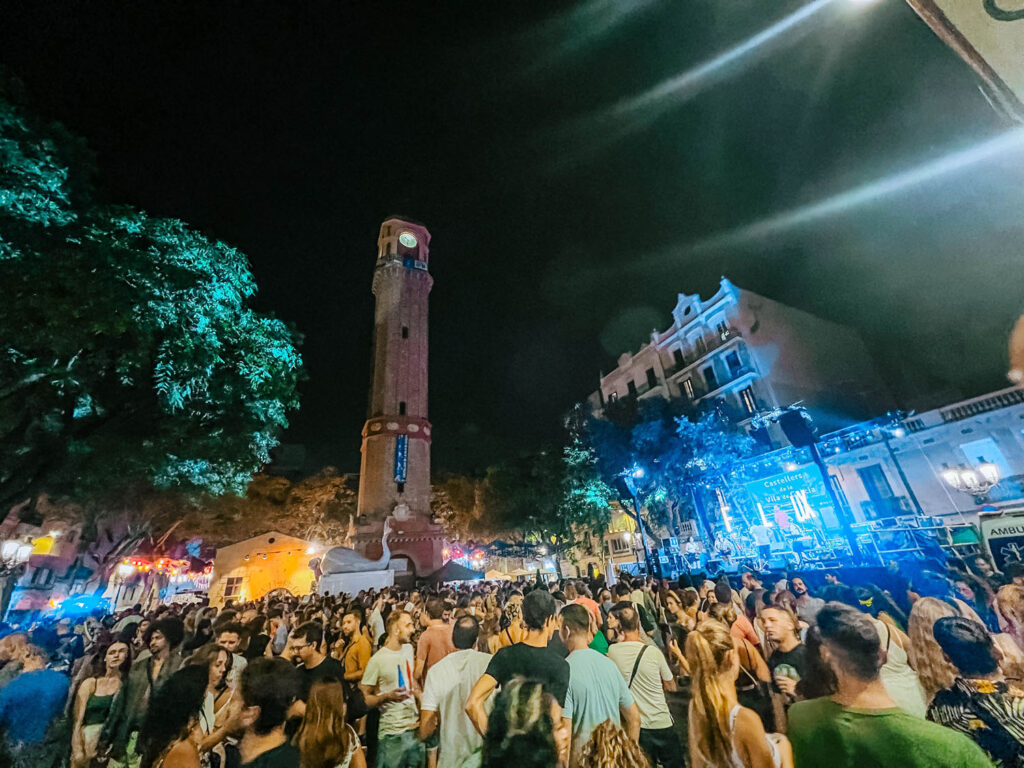
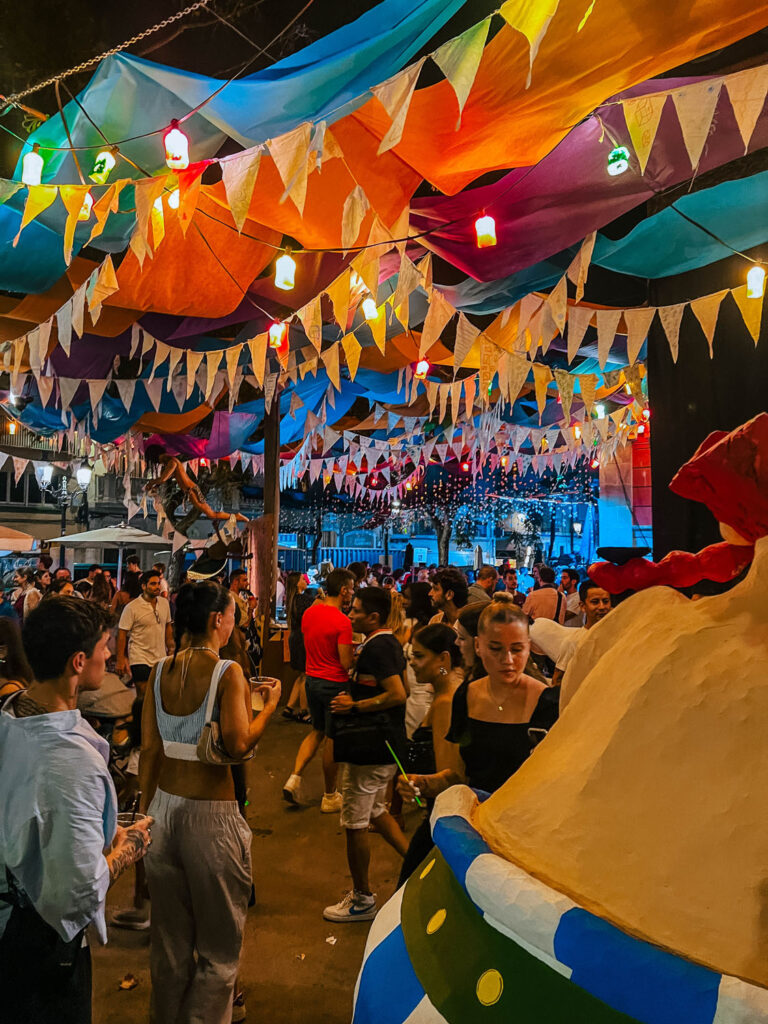
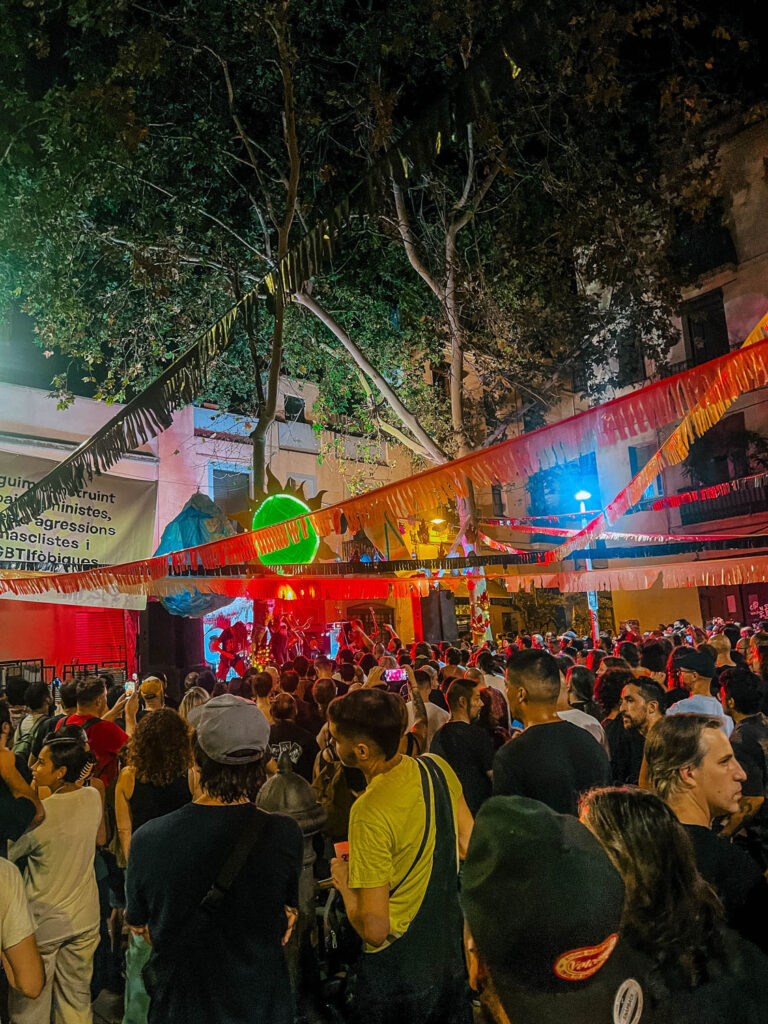
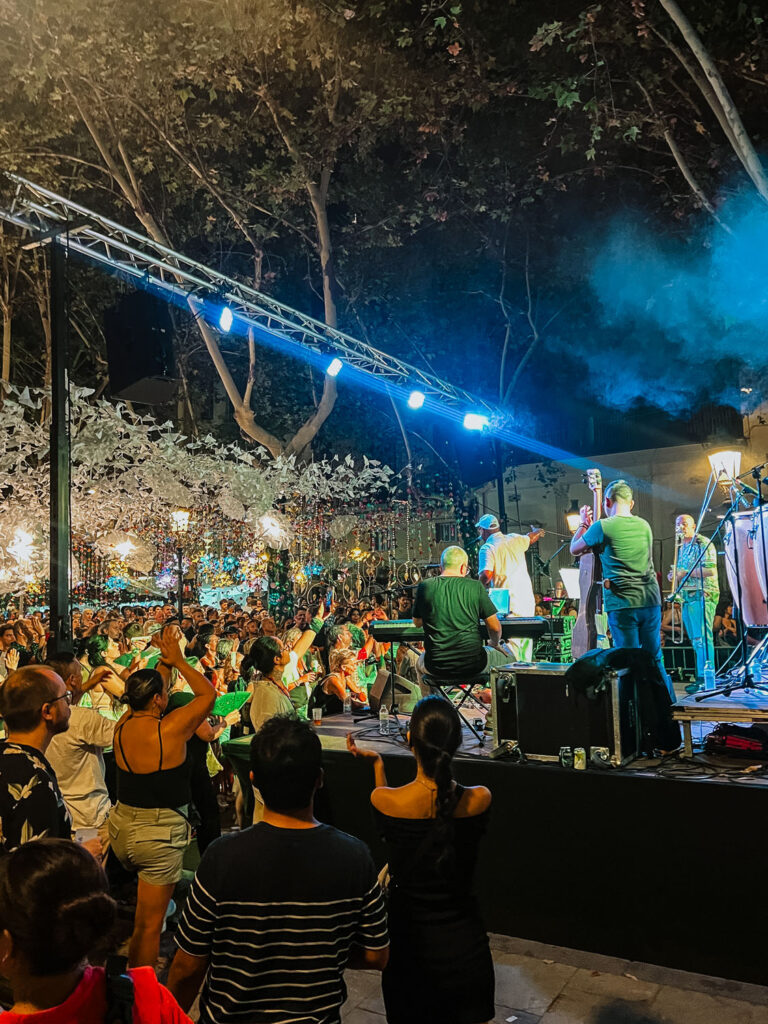
How to Navigate the Crowds
There is no getting around to the fact that the festival is super popular with locals and tourists alike. Depending on what time you visit, the streets will be busy. One of the busiest nights is the festival’s first night, and weekends are busier as well. Even during the afternoon, the narrow streets are packed to the gills with people, so if you want to experience the streets without too many people, definitely head down during the early morning. There are many great coffee shops in Gracia, so grab yourself a coffee and wander the vibrant street displays. Below is an example of the same street early in the morning vs late afternoon.

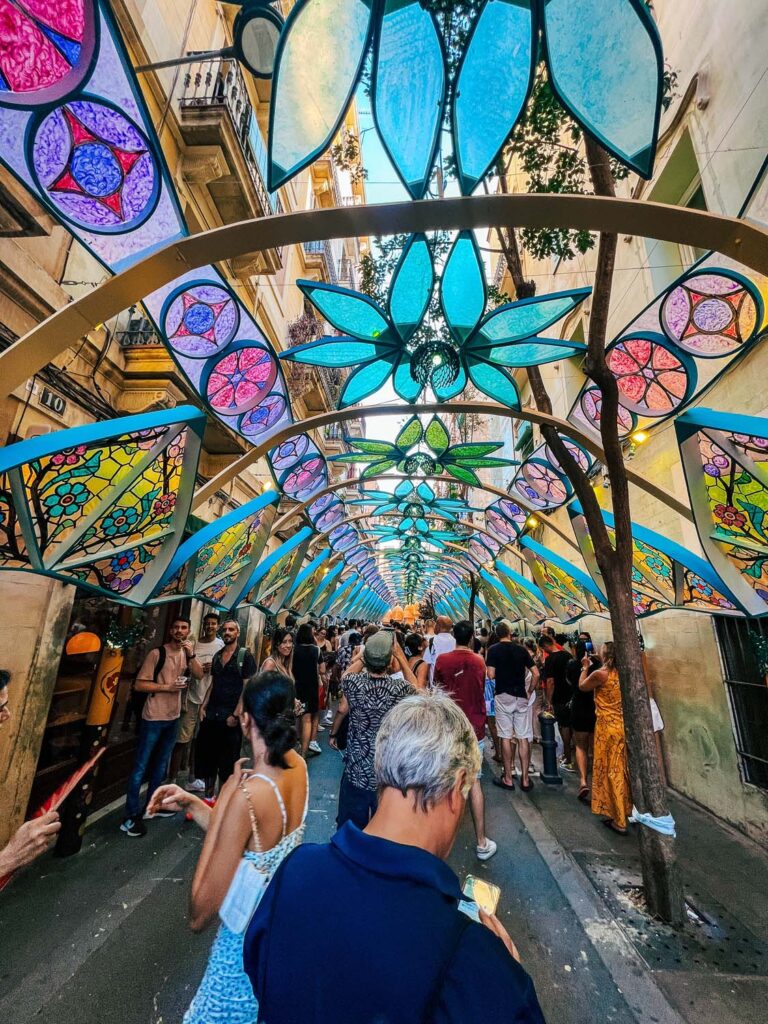
Food and Drinks
During the evenings, the streets take on a different atmosphere, with music stages entertaining visitors and locals and little makeshift bars serving up local drinks like vermouth and tinto de verano (a refreshing drink made by mixing red wine with lemon soda, and sometimes vermouth). This is another great way for the streets to raise money for materials for next year’s festival, so drink deep and well!
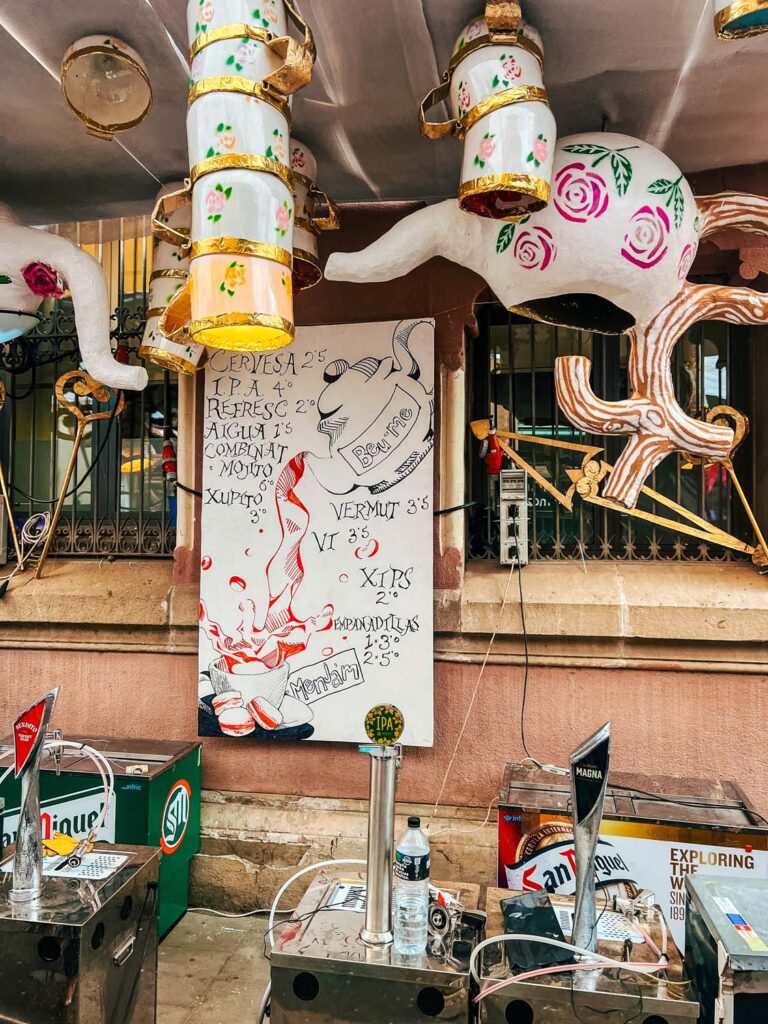
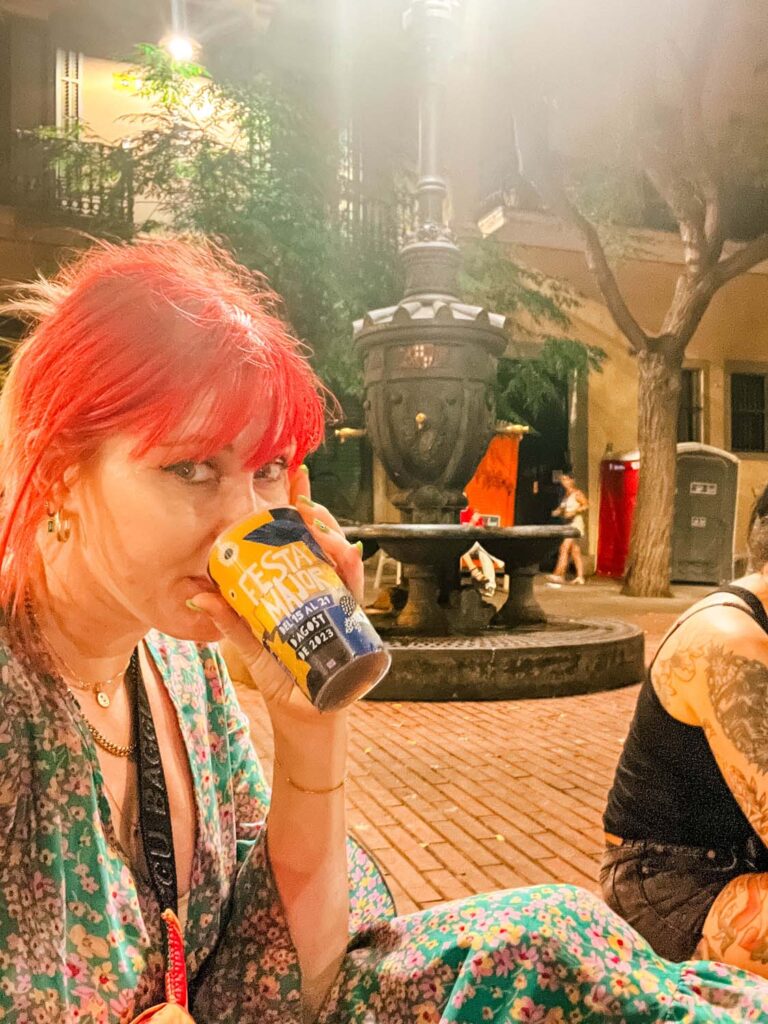

Many local bars and restaurants are filled with a huge influx of visitors, but they have created ingenious stands outside the main restaurants that serve the most popular food and drinks usually served inside the restaurant.
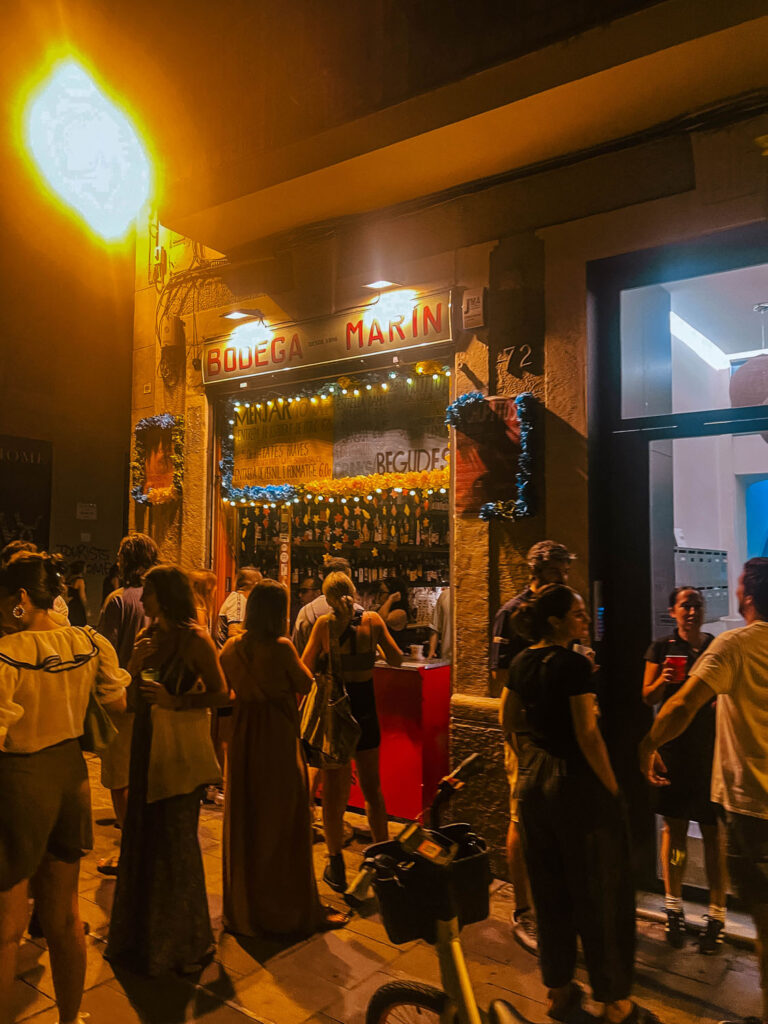
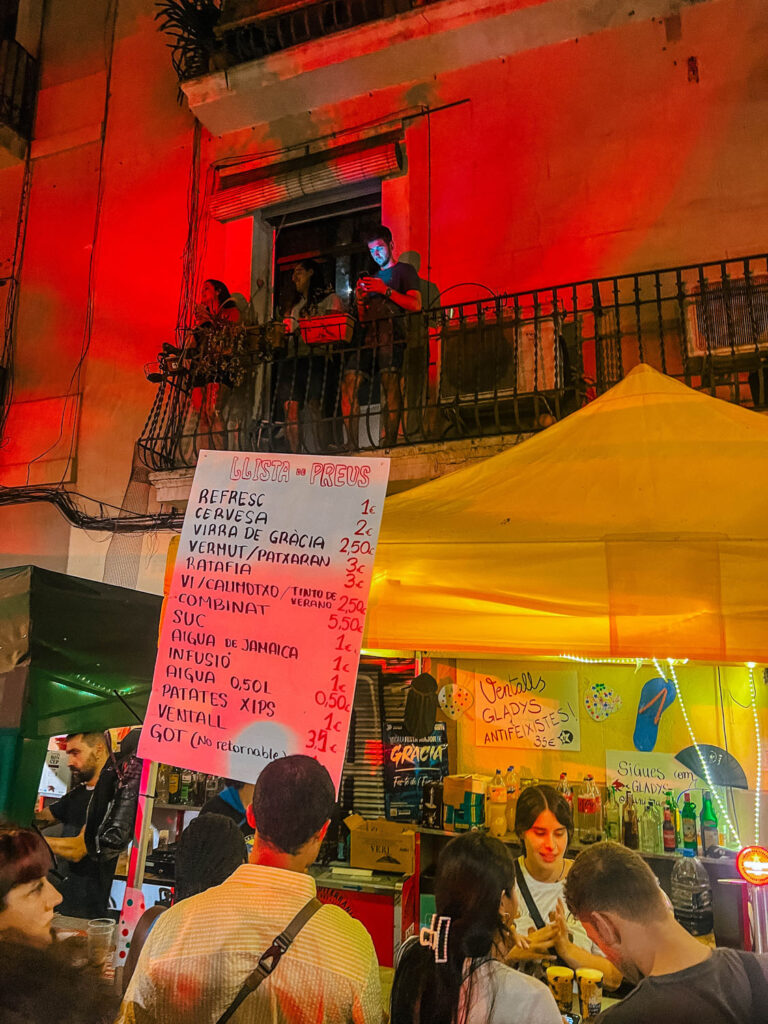
I hope this guide has inspired you to experience this magical festival firsthand. There’s something truly special about the way the community comes together to create such a spectacular event filled with joy, creativity, and tradition. Whether you’re dancing to live music, marvelling at the intricate decorations, or simply soaking in the festive atmosphere, the memories you make here will be unforgettable.
Happy Travels, Adventurers, and see you at the Festa!


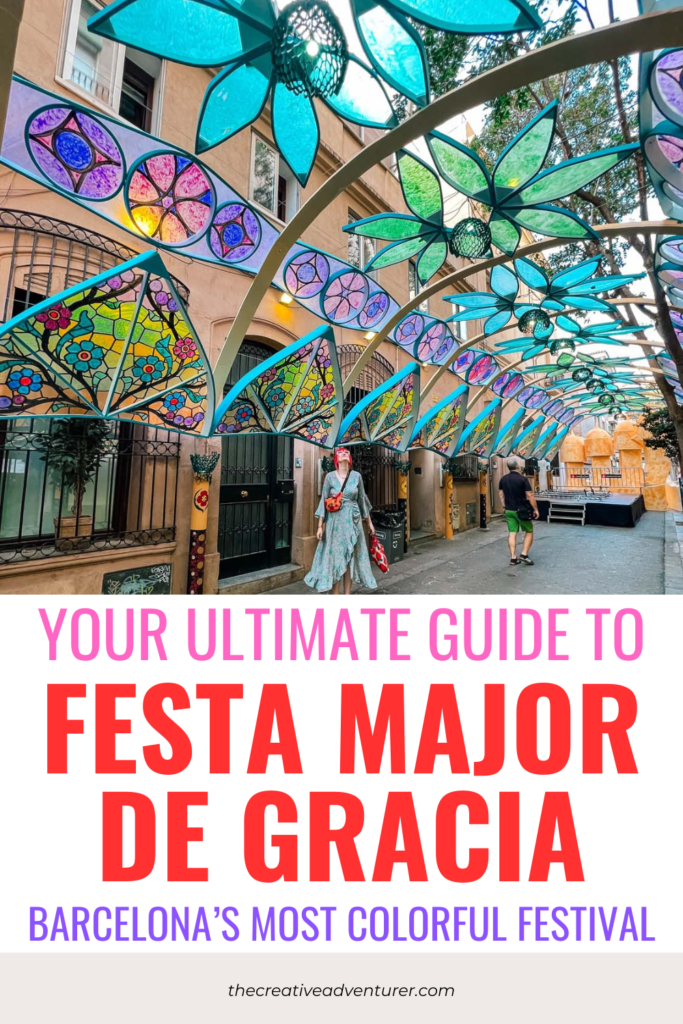
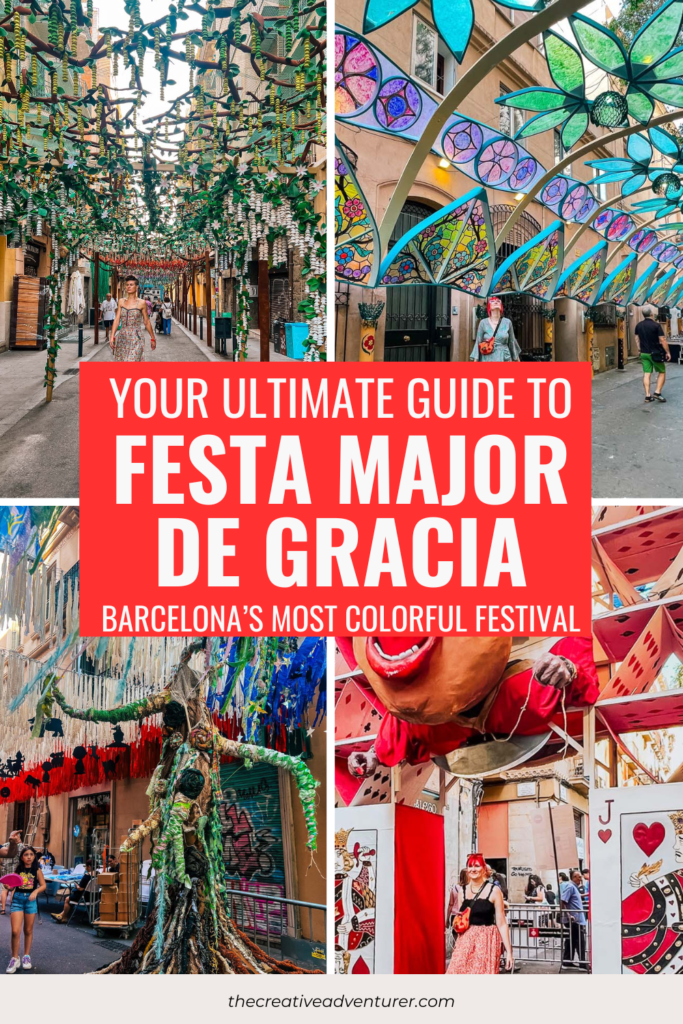
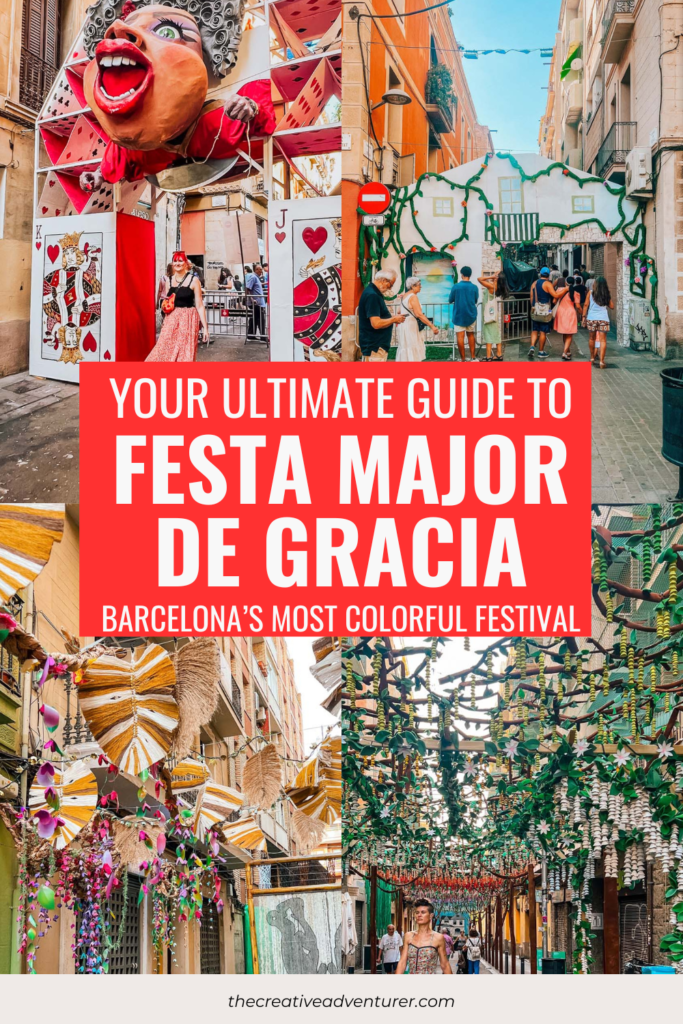



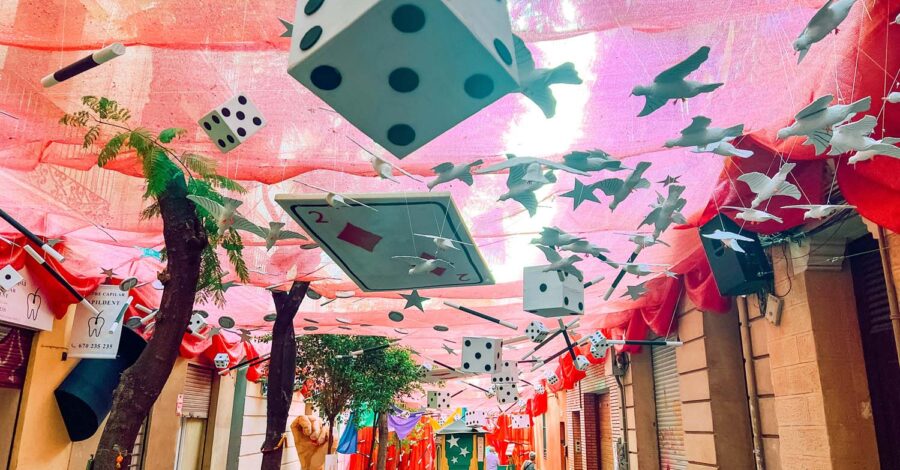
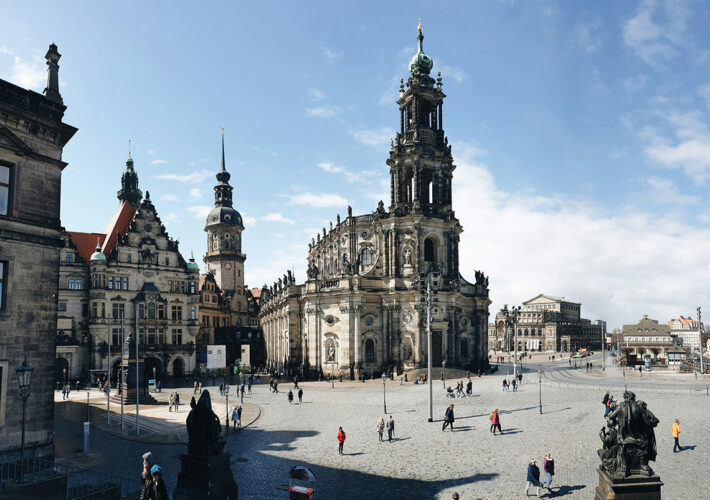
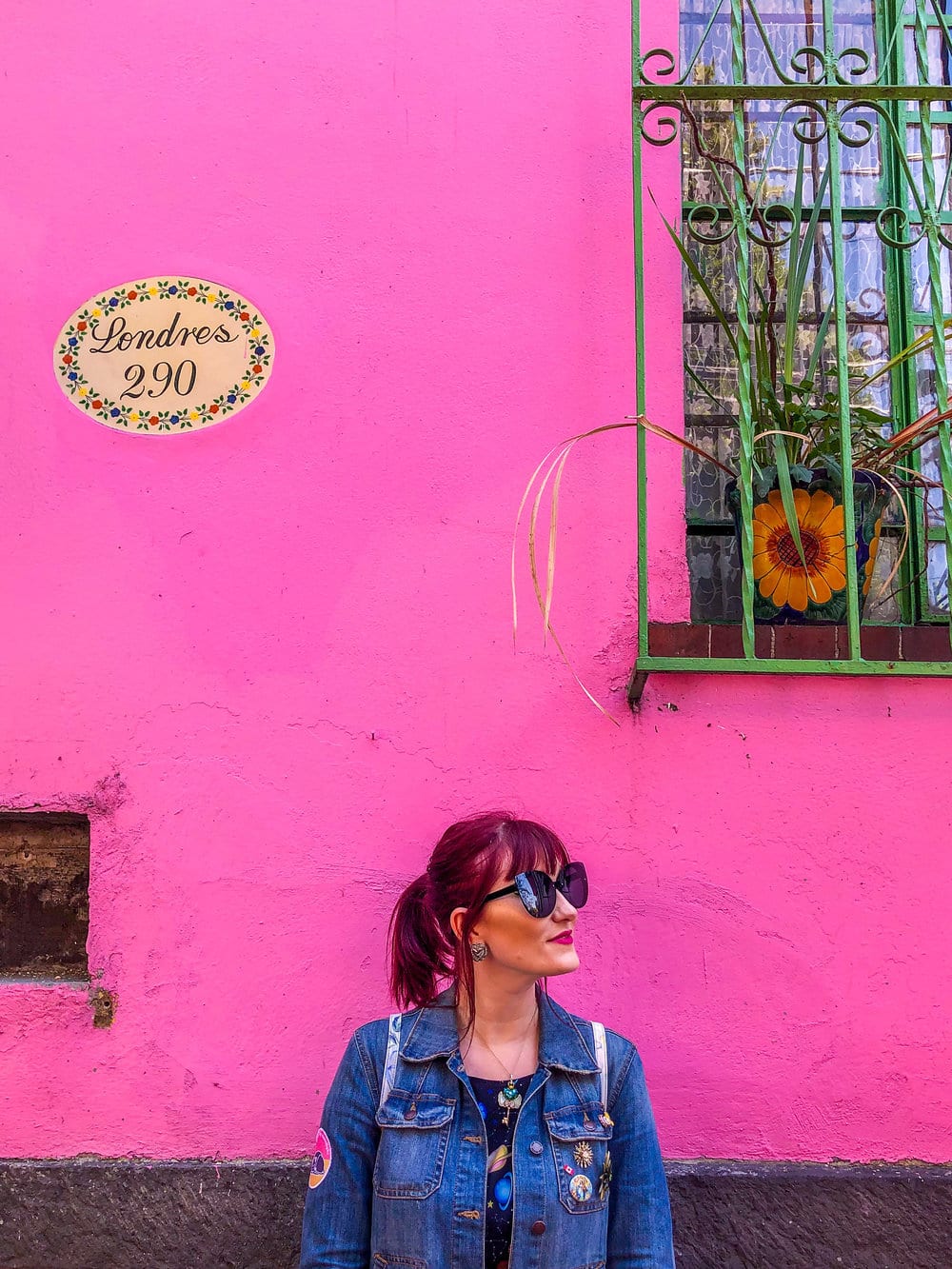
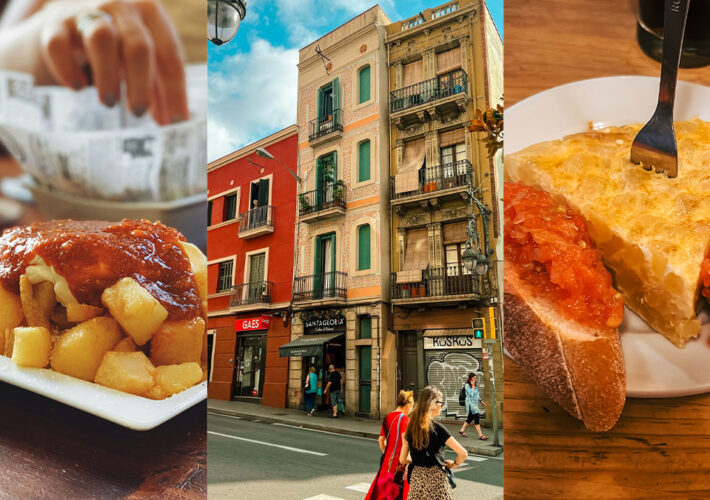

Leave a Comment